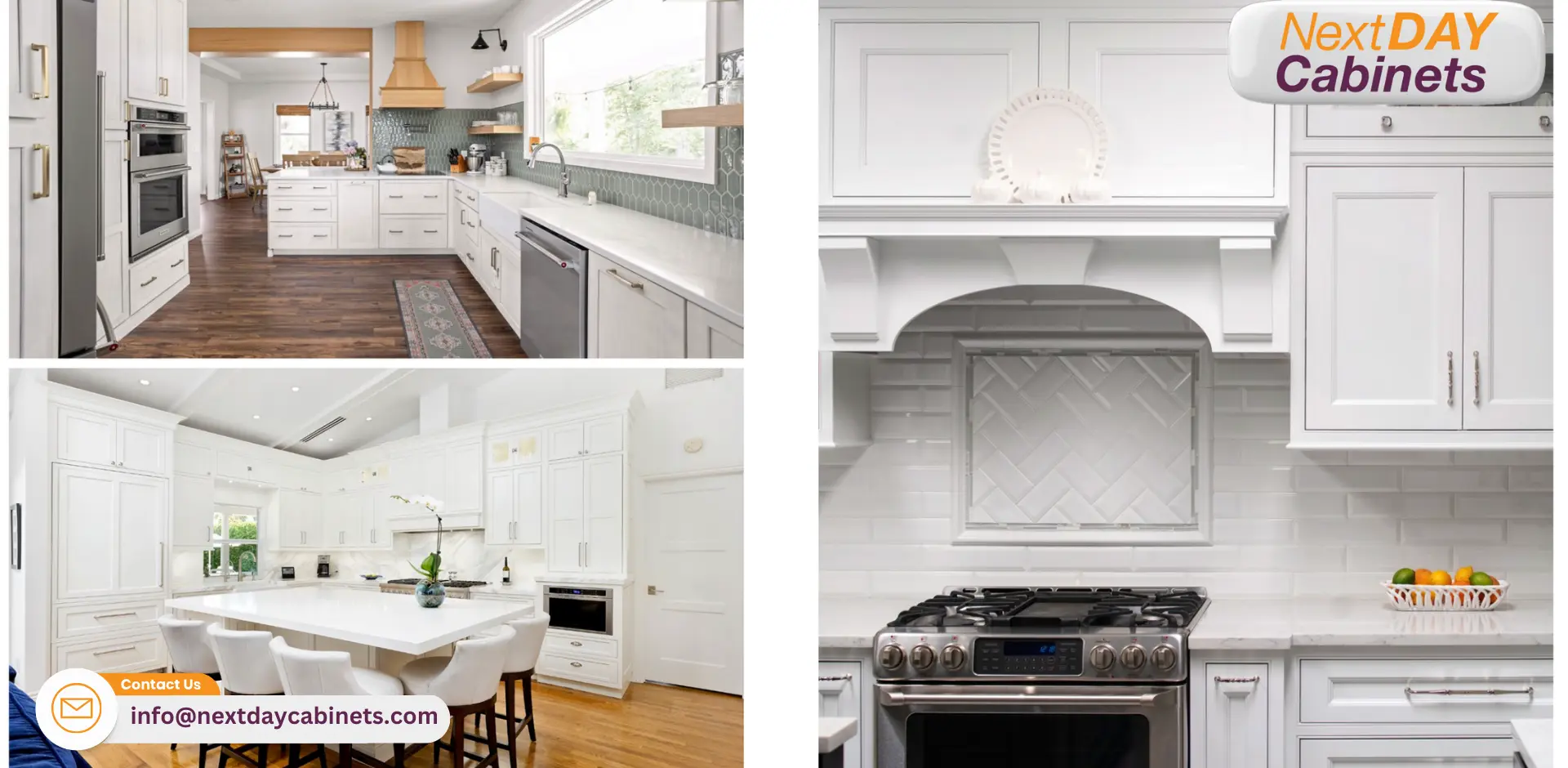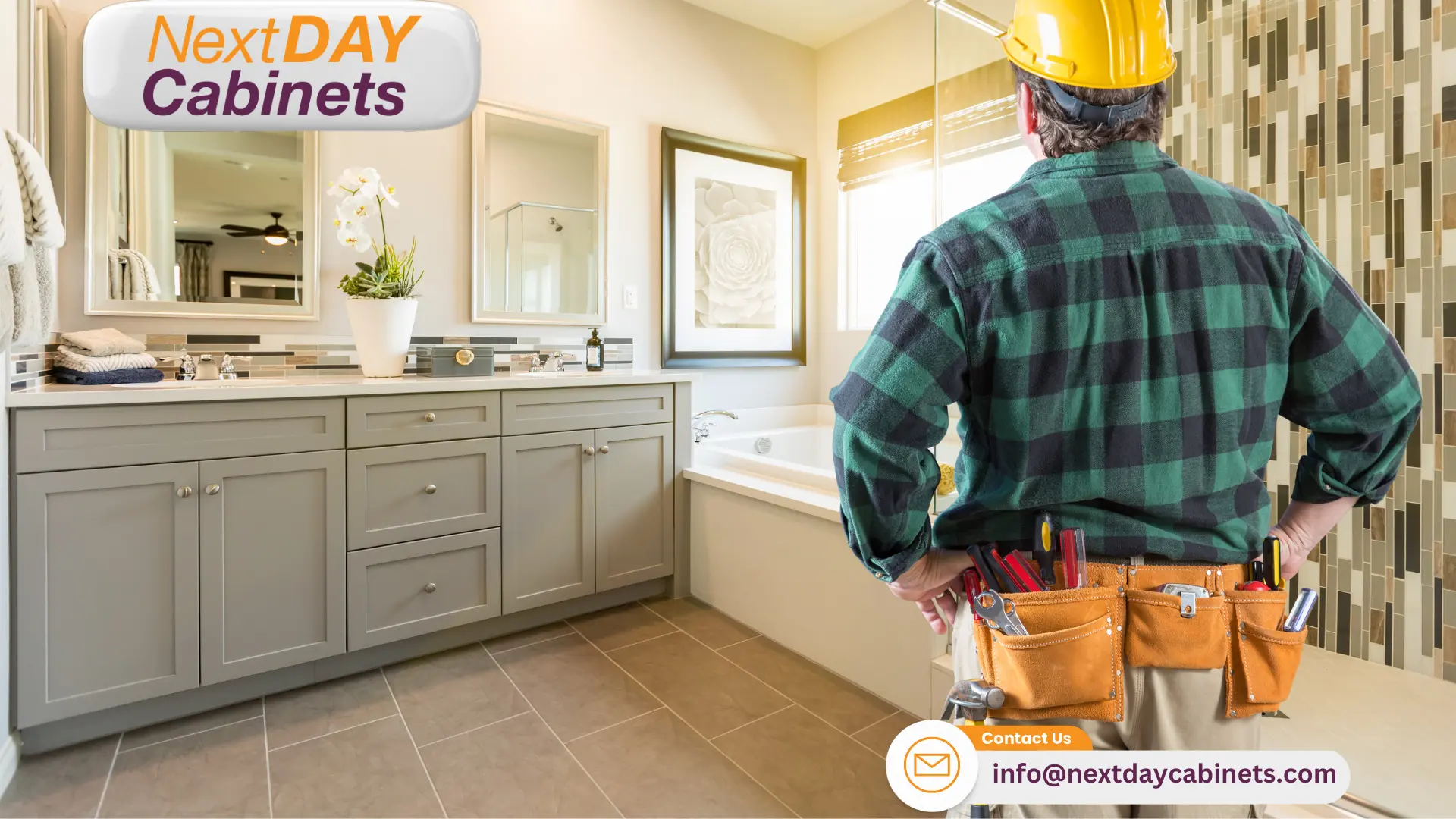
2024 Contractor’s Guide: Choosing Bathroom Vanities Wisely
Selecting the right bathroom vanity can significantly impact the success of your renovation project. This guide offers essential insights for contractors and homeowners in Northern Virginia, Richmond, VA, and throughout Virginia for choosing the perfect vanity in 2024.
We’ll cover key considerations like space optimization, material selection, and style matching, ensuring your bathroom renovation meets both functional needs and aesthetic preferences. With Nextday Cabinets‘ expertise, you’ll learn how to make informed decisions that enhance your bathroom‘s value and appeal.

Key Takeaways for 2024 Guide to Choosing Bathroom Vanities: A Contractor’s Guide
Accurate Measurements: Precise measurements of the bathroom space are essential for selecting a well-suited vanity and allow for proper clearance around doors and fixtures.
Plumbing and Electrical Assessments: Evaluating existing plumbing and electrical layouts is crucial to ensure compatibility with the new vanity and avoid costly installation modifications.
Space Optimization: Understanding the layout, including door swings and traffic flow, helps in choosing a vanity that enhances accessibility and functionality within the bathroom.
Vanity Size and Configuration: The right size—whether a single or double vanity—depends on the space available, client preferences, and intended use, ensuring a balance between aesthetics and practicality.
Material Choices: The durability of bathroom vanities is influenced by material selection; options like solid wood, MDF, and particleboard each have unique benefits regarding moisture resistance and cost.
Countertop Materials: Contractors should consider various countertop materials such as quartz and granite, balancing durability, maintenance needs, and aesthetic appeal to complement the vanity design.
Storage Solutions: Effective storage solutions, including drawers, cabinets, and open shelving, are vital for keeping the bathroom organized while maximizing available space.
Sink Selection: Choosing between undermount and vessel sinks impacts functionality and design; contractors must consider height requirements and faucet styles’ compatibility.
Faucet Types: Selecting the right faucet involves assessing water efficiency, ease of use, and aesthetic compatibility with the chosen sink and vanity design.
Lighting Considerations: Proper lighting enhances usability; contractors should recommend fixtures that provide adequate illumination for grooming tasks while complementing the bathroom aesthetic.
Mirror Selection: Mirrors should match the vanity’s style while ensuring practical functionality; options include frameless designs for modern looks or framed mirrors for a more traditional feel.
Smart Features Integration: Incorporating technology such as smart mirrors with built-in lighting can enhance the user experience by providing convenience and modern functionality in bathroom vanities.
Understanding Your Bathroom Space and Layout
Selecting the right bathroom vanity from NextDAY Cabinets requires thoroughly understanding the space. To Become a Dealer, this section covers essential aspects: measuring for the perfect fit, assessing plumbing and electrical considerations, and accounting for door and traffic flow. These factors ensure that the chosen bathroom vanities look great and function seamlessly within the layout.
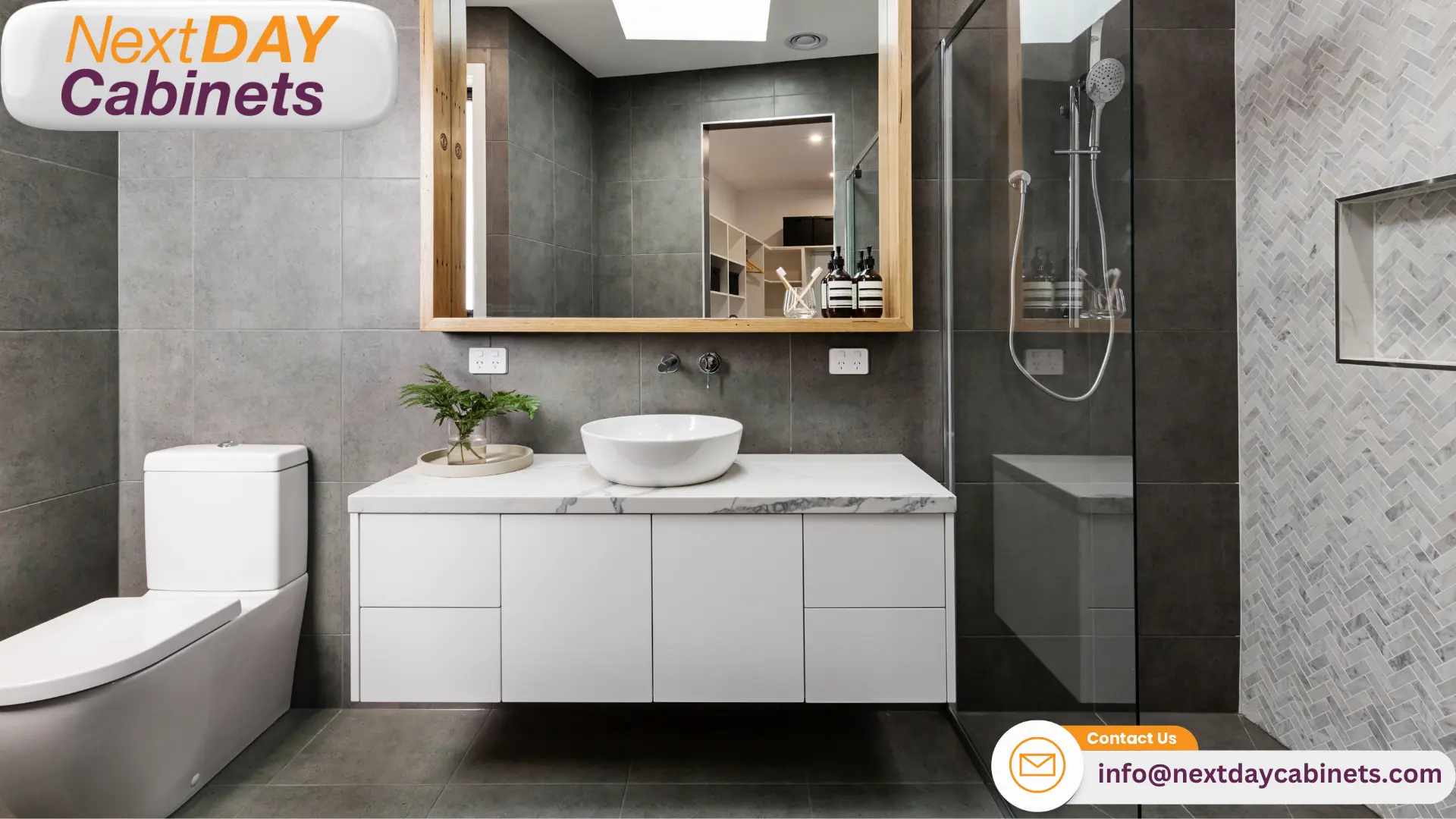
Measuring for the Perfect Fit
Accurate measurements are crucial when selecting a bathroom vanity for a renovation project. Contractors should measure the available space precisely, considering the width, depth, and height of the area where the vanity will be installed. This ensures that the chosen vanity fits seamlessly within the bathroom layout, leaving sufficient clearance for doors, drawers, and surrounding fixtures such as the toilet and shower.
When measuring for vanity, it’s essential to account for any existing plumbing connections and potential obstructions. Contractors should factor in the location of water supply lines, drain pipes, and electrical outlets to determine the ideal placement and size of the vanity. By considering these measurements and considerations, professionals can recommend vanities that maximize space utilization while maintaining functionality in the renovated bathroom.
Assessing Plumbing and Electrical Considerations
Assessing plumbing and electrical considerations is crucial when selecting bathroom vanities. Contractors must evaluate the existing plumbing layout, including the location of water supply lines and drain pipes, to ensure compatibility with the chosen wood cabinetry. This assessment helps determine if any modifications are necessary to accommodate the new bathroom sink and vanity configuration.
Electrical considerations are equally important when installing bathroom vanities. Contractors should identify the placement of electrical outlets and lighting fixtures in the proposed vanity location. This evaluation ensures the countertop area has adequate lighting and convenient access to power sources for grooming appliances. Proper planning of plumbing and electrical elements contributes to a functional and aesthetically pleasing bathroom design:
| Consideration | Impact on Vanity Selection |
|---|---|
| Plumbing Layout | Determines vanity size and placement |
| Electrical Outlets | Influences countertop design and storage options |
| Lighting Fixtures | Affects mirror placement and overall functionality |
Accounting for Door and Traffic Flow
Accounting for door and traffic flow is essential when selecting bathroom vanities. Contractors must consider the swing of doors, including the bathroom entrance and cabinet doors, to ensure they don’t interfere with the vanity or impede movement. This assessment helps prevent potential water damage and ensures proper accessibility, especially in compact spaces where careful planning is crucial.
The placement of the vanity should allow for comfortable navigation around the bathroom. Contractors should evaluate the flow between key elements such as the shower, toilet, and vanity, ensuring sufficient clearance for daily activities. This approach enhances functionality and contributes to a more efficient plumbing layout, which can be beneficial when integrating elements from other areas, like the kitchen, into the bathroom design.
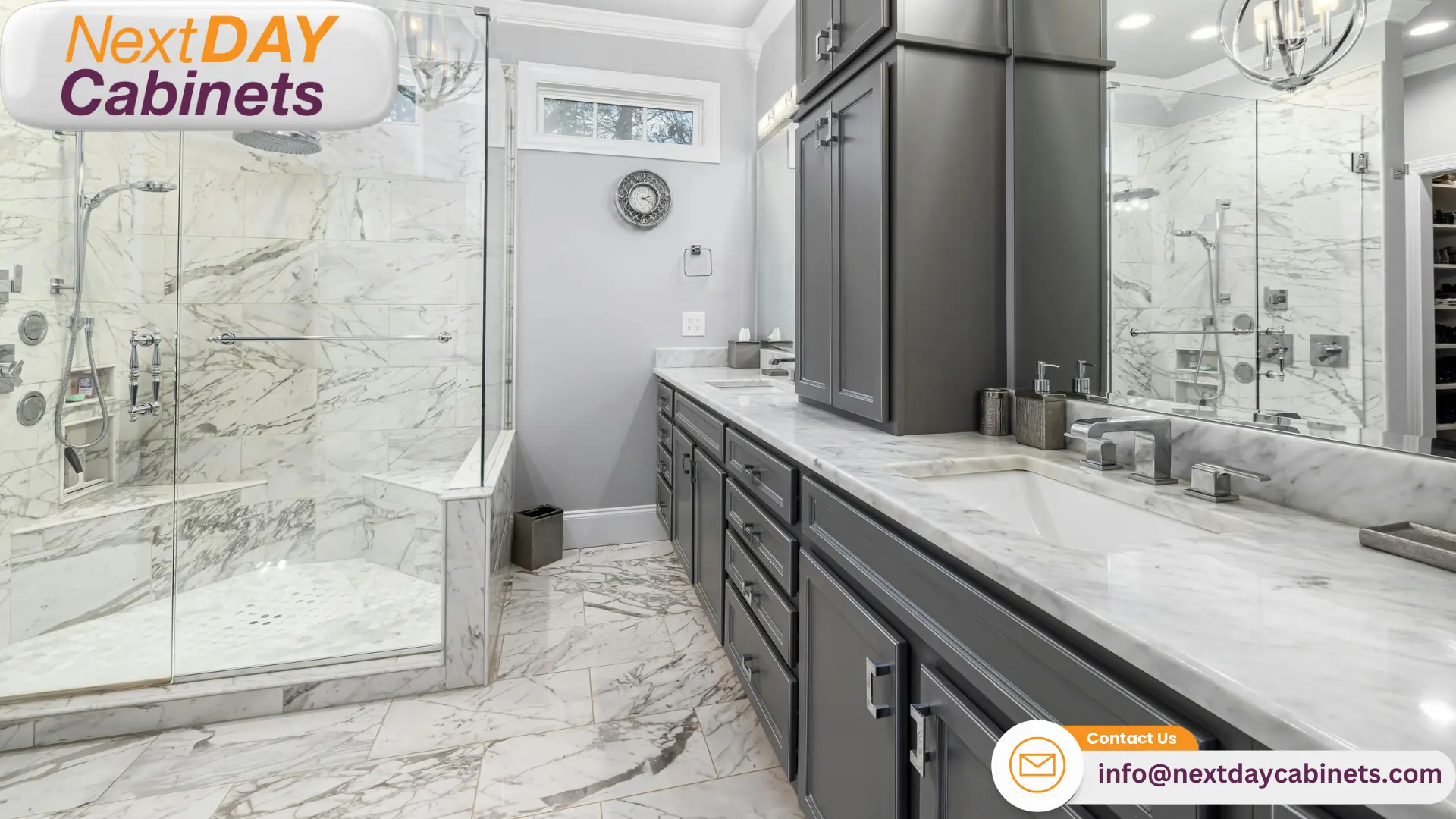
Selecting the Right Vanity Size and Configuration
The right vanity size and configuration are crucial for a successful bathroom design. This section explores single and double vanity options, corner and custom solutions, and the balance between functionality and aesthetics. Contractors will learn how to incorporate elements like marble countertops, wall-mounted designs, and efficient drawer storage to create optimal bathroom layouts for their clients.
Choosing Between Single and Double Vanities
Contractors must consider various factors when deciding between single and double vanities for bathroom renovations. Single vanities are ideal for smaller spaces, providing a streamlined look and maximizing floor area. Double vanities offer increased functionality and storage capacity, making them suitable for larger bathrooms or shared spaces. These options depend on the available space, client preferences, and budget constraints.
When selecting vanities, aesthetics are crucial in the overall bathroom design. Contractors should consider the style of the mirror, countertop material (such as quartz), and cabinet finishes to create a cohesive look. Factors like heat resistance and durability should also be evaluated to ensure long-lasting performance. The following table outlines key considerations for single and double vanities:
| Vanity Type | Space Requirements | Storage Capacity | Typical Budget Range |
|---|---|---|---|
| Single Vanity | 24-48 inches wide | Limited | $500-$2,000 |
| Double Vanity | 60-72 inches wide | Ample | $1,000-$5,000+ |
Exploring Corner and Custom Vanity Options
Corner vanities offer an innovative solution for maximizing space in compact bathrooms. These units fit snugly into corners, utilizing often neglected room areas. Contractors can recommend corner vanities with granite countertops to add a touch of elegance while ensuring durability. The unique design of corner vanities allows for efficient use of floor space, making them ideal for smaller bathrooms or powder rooms.
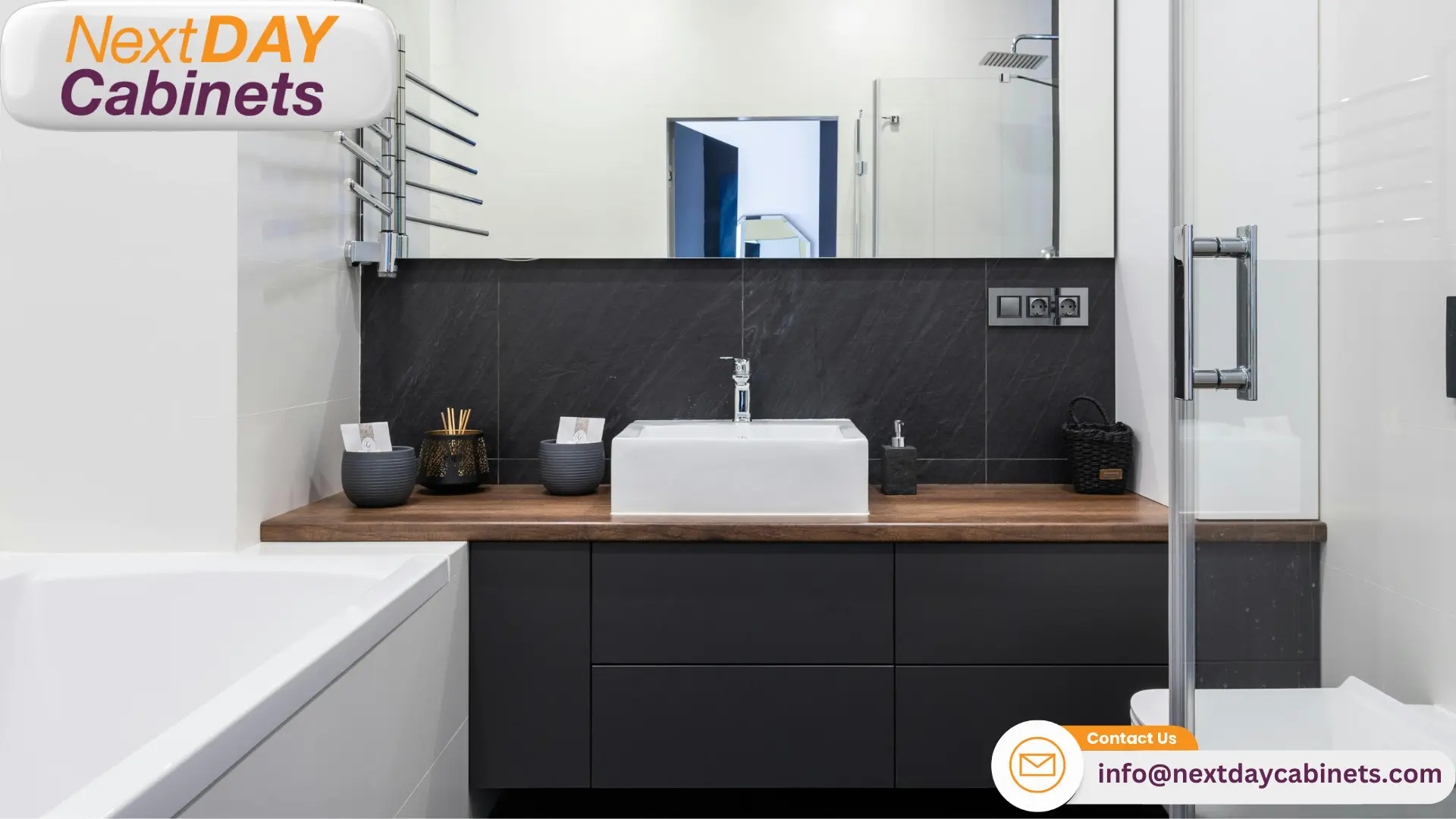
Custom vanities provide unparalleled flexibility in bathroom design
| Vanity Type | Space Efficiency | Customization Level | Typical Materials |
|---|---|---|---|
| Corner Vanity | High | Limited | Granite, Wood |
| Custom Vanity | Variable | High | Solid Wood, Fiberboard |
Balancing Functionality and Aesthetics
Balancing functionality and aesthetics in bathroom vanity selection requires careful consideration of materials and design
Incorporating sleek storage solutions and efficient layouts enhances functionality without compromising style. Contractors can suggest wall-mounted vanities to create a sense of spaciousness, especially in smaller bathrooms. By prioritizing both form and function, professionals ensure that the chosen vanity meets the client’s practical needs and contributes to the overall visual impact of the bathroom design.
Material Choices for Durability and Style
Material selection is crucial for bathroom vanities, impacting durability and style. This section examines solid wood, MDF, and particleboard options, explores countertop materials like quartz and granite, and evaluates hardware quality and finishes. Contractors will learn to balance aesthetics with functionality, considering factors such as lighting, dimensions, and glass elements for successful bathroom remodels.
Comparing Solid Wood, MDF, and Particleboard
Contractors must consider the unique properties of solid wood, MDF, and particleboard when selecting materials for bathroom vanities during bathroom remodeling projects. Solid wood offers durability and a timeless aesthetic, making it an excellent choice for homeowners seeking a high-end finish in their dream bathroom. However, proper sealing is required to withstand moisture, which may be more expensive than other options.
MDF and particleboard provide cost-effective alternatives for bathroom renovation projects with varying levels of moisture resistance and structural integrity. These engineered wood products offer versatility in design and can be an ideal choice for creating ample storage space in vanities. When selecting materials, contractors should consider factors such as:
- Moisture resistance
- Weight-bearing capacity
- Cost-effectiveness
- Ease of maintenance
- Compatibility with chosen finishes.
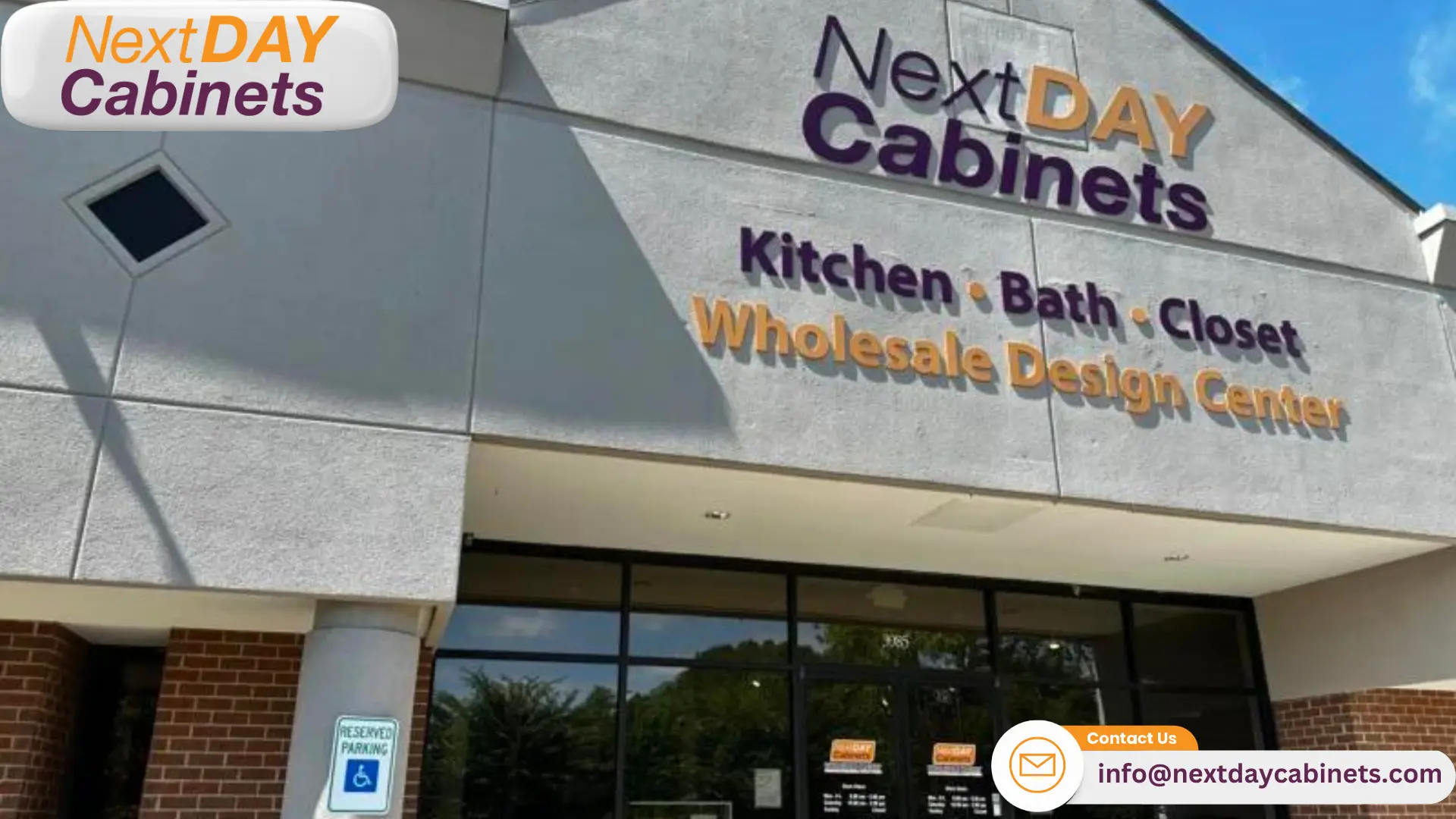
Exploring Countertop Materials: Quartz, Granite, and More
Contractors must carefully consider various countertop materials when selecting bathroom vanities, balancing durability, aesthetics, and cost. Quartz, a popular engineered stone, offers exceptional moisture resistance and low maintenance, making it ideal for high-humidity bathroom environments. Granite, a natural stone, provides unique patterns and heat resistance but requires periodic sealing to maintain its integrity against moisture.
Other options include solid surface materials, which offer seamless integration with sinks and backsplashes and engineered wood countertops, such as those made from oak, which can provide a warm, natural look. When evaluating countertop materials, contractors should consider factors like price, durability, and compatibility with the overall bathroom design, ensuring the chosen material complements the vanity‘s wood construction and meets the client’s specific needs.
Evaluating Hardware Quality and Finishes
When evaluating hardware quality for bathroom vanities, contractors should consider the durability and finish of components such as handles, knobs, and hinges. High-quality hardware resists corrosion from humidity and frequent use, ensuring longevity in the bathroom environment. Stainless steel and brass finishes offer excellent resistance to moisture, making them suitable choices for bathroom applications.
Contractors should also assess the functionality of hardware, such as soft-close drawer slides and adjustable hinges, which enhance the user experience. Often found in kitchen cabinets, these features can be equally beneficial in bathroom vanities, especially for storing cosmetics and toiletries. When selecting finishes, professionals should consider how they complement the overall design aesthetic and their ability to withstand potential water exposure, particularly in basement bathrooms with higher humidity levels.
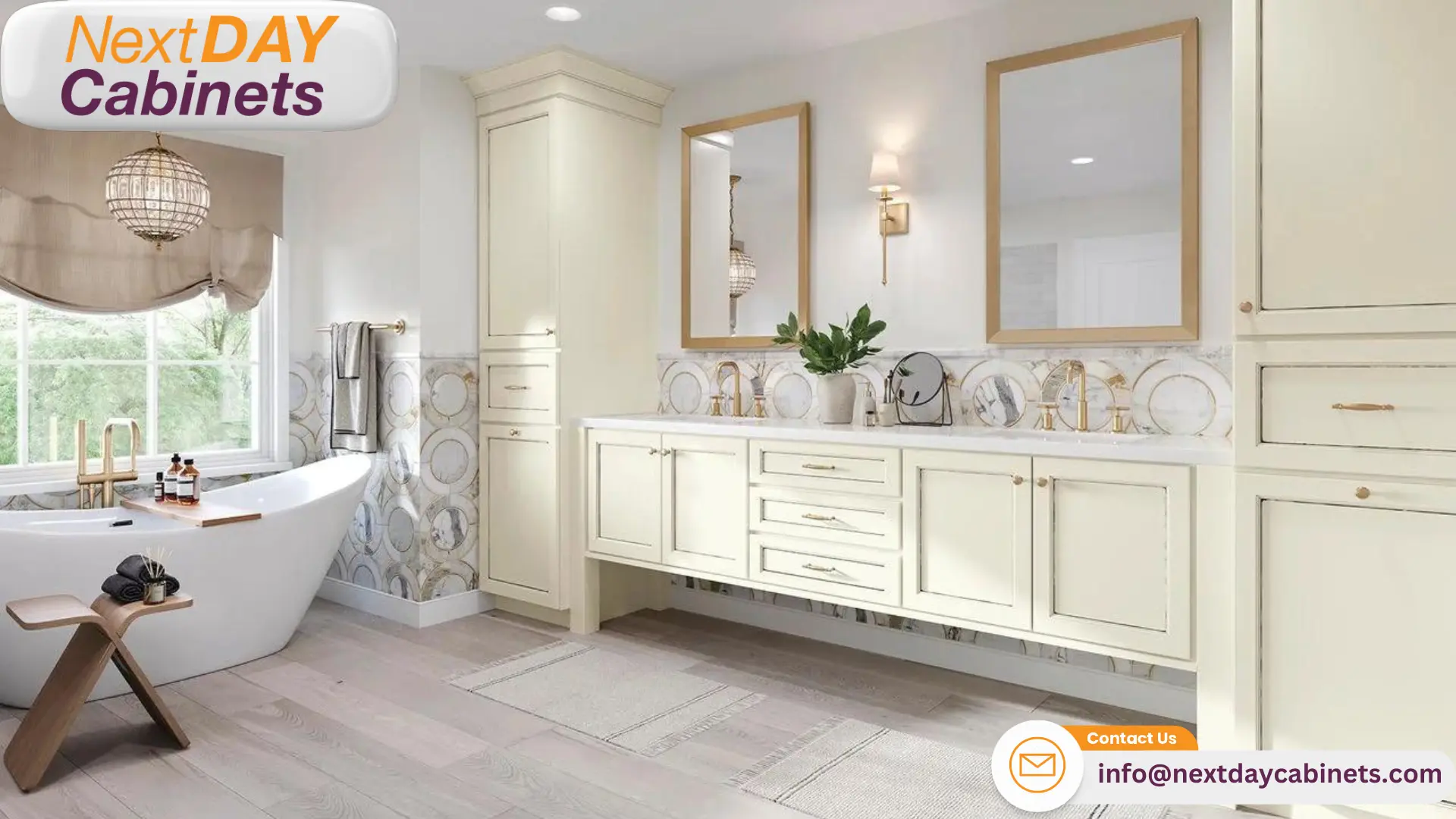
Matching Vanity Styles With Bathroom Themes
Matching vanity styles with bathroom themes enhances the overall beauty and cohesion of the space. This section explores modern vs. traditional designs, incorporating rustic and farmhouse elements and customizing with color and texture. Contractors will learn to select vanities that complement various bathroom themes, considering factors such as paint choices, sconce lighting, and particle board options for home improvement projects.
Modern vs. Traditional Designs
Modern bathroom vanity designs often feature clean lines, minimalist aesthetics, and innovative materials like ceramic countertops. These contemporary styles frequently incorporate sleek hardware and floating designs, creating an illusion of space in compact bathrooms. Contractors can recommend modern vanities in various sizes, from compact 24-inch models to expansive 60-inch double vanities, to suit different bathroom layouts.
Traditional vanity designs, on the other hand, draw inspiration from classic furniture styles, often utilizing solid wood construction and ornate details. These timeless pieces can range from elegant Victorian-inspired designs to rustic farmhouse-style vanities, offering versatility in matching different bathroom themes. Traditional vanities typically feature rich wood tones, decorative moldings, and antique-inspired hardware, providing a warm and inviting atmosphere to the bathroom space.
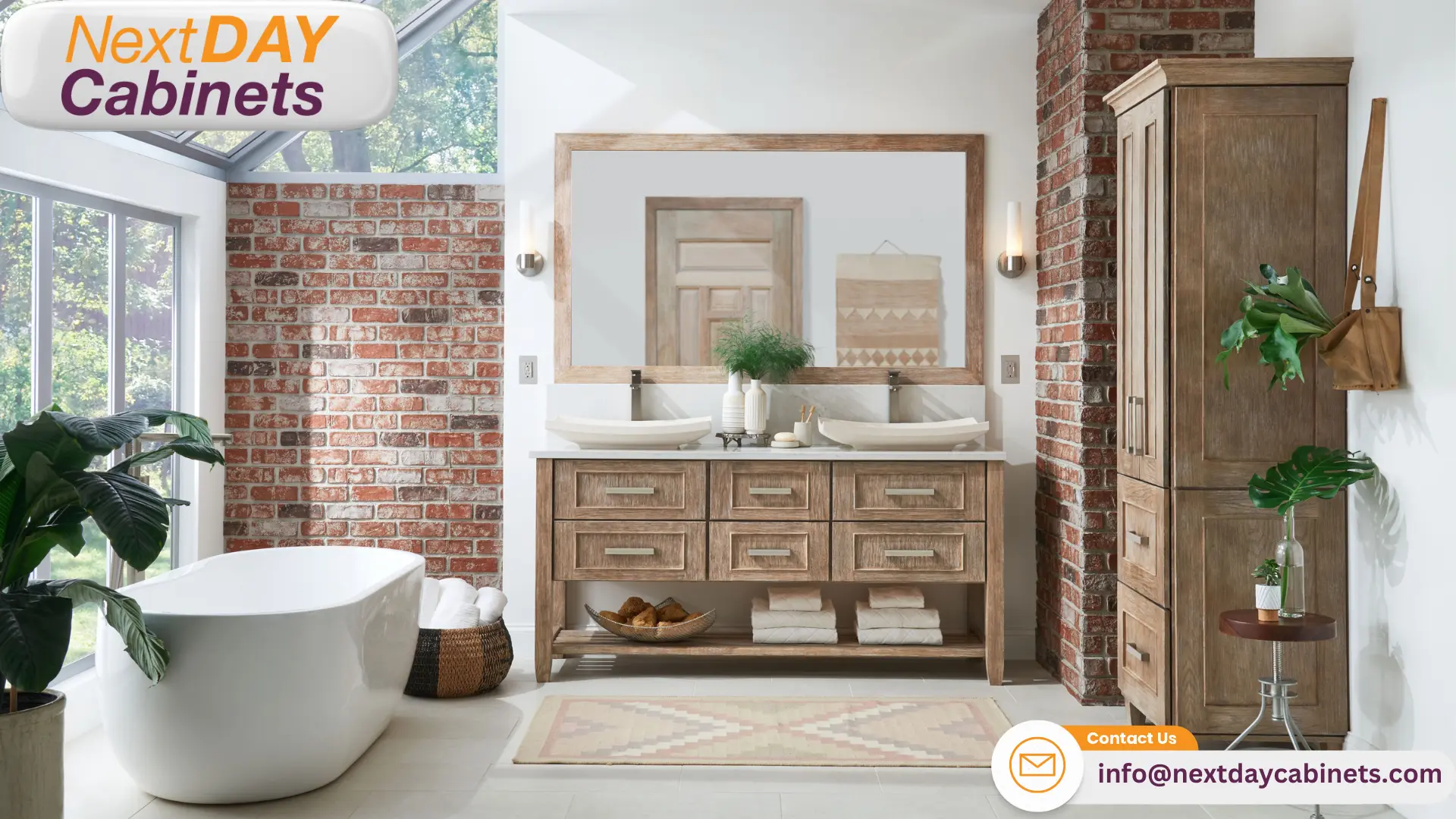
Incorporating Rustic and Farmhouse Elements
Incorporating rustic and farmhouse elements in bathroom vanities adds warmth and character to the space. Contractors can recommend vanities with distressed wood finishes or reclaimed materials to achieve an authentic rustic look. Pairing these vanities with concrete countertops or metal sinks creates a striking contrast, enhancing the overall aesthetic while keeping costs manageable.
To complete the farmhouse theme, professionals should recommend complementary elements such as tile backsplashes with vintage patterns or brushed nickel hardware. These details, combined with the right vanity choice, create a cohesive and inviting bathroom design that aligns with current trends while maintaining timeless appeal:
| Element | Material | Style Impact |
|---|---|---|
| Vanity | Reclaimed Wood | High |
| Countertop | Concrete | Medium |
| Hardware | Brushed Nickel | Low |
| Backsplash | Vintage Tile | Medium |
Customizing With Color and Texture
Customizing bathroom vanities with color and texture allows contractors to create unique spaces that reflect their clients’ personalities. By selecting vanities with vibrant hues or textured finishes, professionals can enhance the bathroom’s visual appeal while maintaining optimal traffic flow. The right color choice can influence the perception of space, making smaller bathrooms appear larger or adding warmth to rooms with high ceilings.
Texture is crucial in bathroom vanity design, offering visual and tactile interest. Contractors can recommend vanities with varying surface treatments, such as distressed wood or brushed metal, to add depth to the bathroom‘s overall aesthetic. When considering texture and color options, professionals should factor in the vanity‘s length and how it impacts the room‘s layout, ensuring that the chosen design complements the existing space without compromising functionality or budget constraints:
- Evaluate the color impact on room perception.
- Consider texture for visual and tactile appeal
- Balance vanity length with room layout
- Assess color and texture choices against the budget
- Ensure that the design enhances the overall bathroom aesthetic.
Storage Solutions for Everyday Needs
Practical storage solutions are essential for functional bathroom vanities. This section explores maximizing space with drawers and cabinets, integrating open shelving options, and utilizing built-in organizers. Contractors will learn how to create efficient storage systems that accommodate everyday needs, ensuring clients have a well-organized bathroom oasis. These insights help professionals deliver practical and stylish vanity solutions, from measuring door clearances to considering electrical requirements.
Maximizing Space With Drawers and Cabinets
Maximizing space with drawers and cabinets is crucial for creating efficient bathroom vanities. Contractors should recommend configurations that optimize storage capacity while maintaining a sleek appearance. Utilizing full-extension drawers and adjustable shelves within cabinets allows for customizable storage solutions that accommodate various personal care items and toiletries.
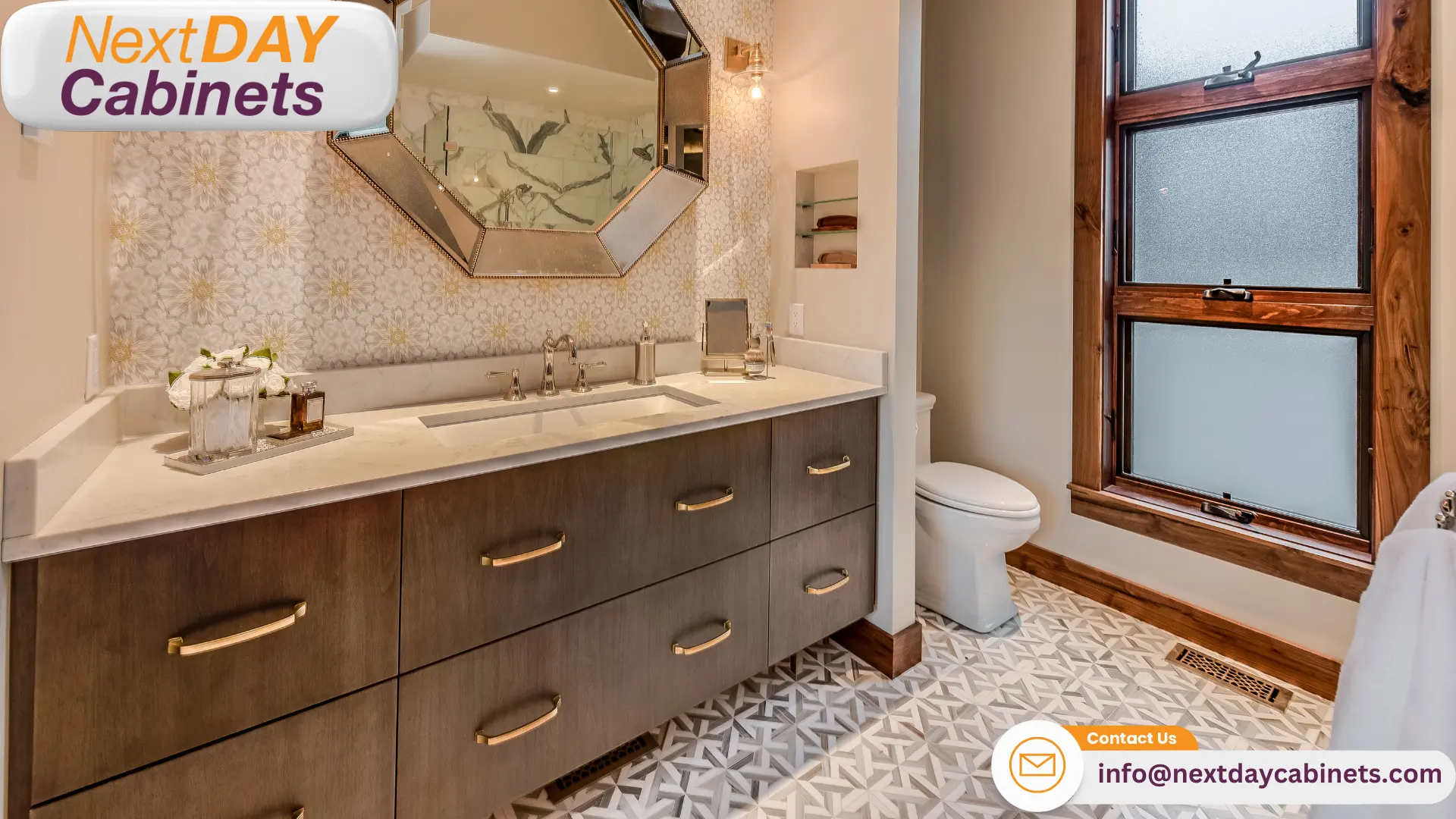
Implementing innovative storage features can significantly enhance the functionality of bathroom vanities. Contractors can suggest incorporating pull-out organizers, vertical dividers, and tiered drawer systems to maximize every inch of available space. These thoughtful additions help clients keep their bathrooms organized and clutter-free, improving the overall user experience:
- Full-extension drawers for easy access
- Adjustable shelves for versatile storage
- Pull-out organizers for small items
- Vertical dividers for efficient space utilization
- Tiered drawer systems for enhanced organization.
Integrating Open Shelving Options
Integrating open shelving options into bathroom vanities offers a modern and versatile storage solution. Contractors can recommend open shelving designs that create a sense of spaciousness while providing easy access to frequently used items. These shelves can be incorporated alongside traditional cabinets or as standalone units, offering flexibility in design and functionality.
Contractors should consider material durability and moisture resistance when implementing open shelving. Glass or metal shelves can provide a sleek, contemporary look while withstanding bathroom humidity. Additionally, strategic placement of open shelves can enhance the overall aesthetic, allowing clients to display decorative items or neatly arranged essentials:
| Shelf Material | Durability | Moisture Resistance | Aesthetic Appeal |
|---|---|---|---|
| Glass | Medium | High | Modern, Sleek |
| Metal | High | High | Industrial, Contemporary |
| Wood | Medium | Low (requires treatment) | Warm, Natural |
Utilizing Built-in Organizers and Accessories
Built-in organizers and accessories enhance bathroom vanity functionality, offering tailored storage solutions for various items. Contractors can recommend pull-out trays for hair tools, adjustable drawer dividers for cosmetics, and specialized toiletry compartments. These customized features maximize space utilization and improve organization, catering to clients’ needs.
Integrating accessories such as built-in power outlets, USB charging ports, and LED-illuminated drawers adds convenience and modern appeal to bathroom vanities. Contractors should consider incorporating these elements to meet the growing demand for tech-friendly bathrooms. By offering these innovative storage solutions, professionals can differentiate their services and provide added value to clients seeking efficient and stylish bathroom designs.
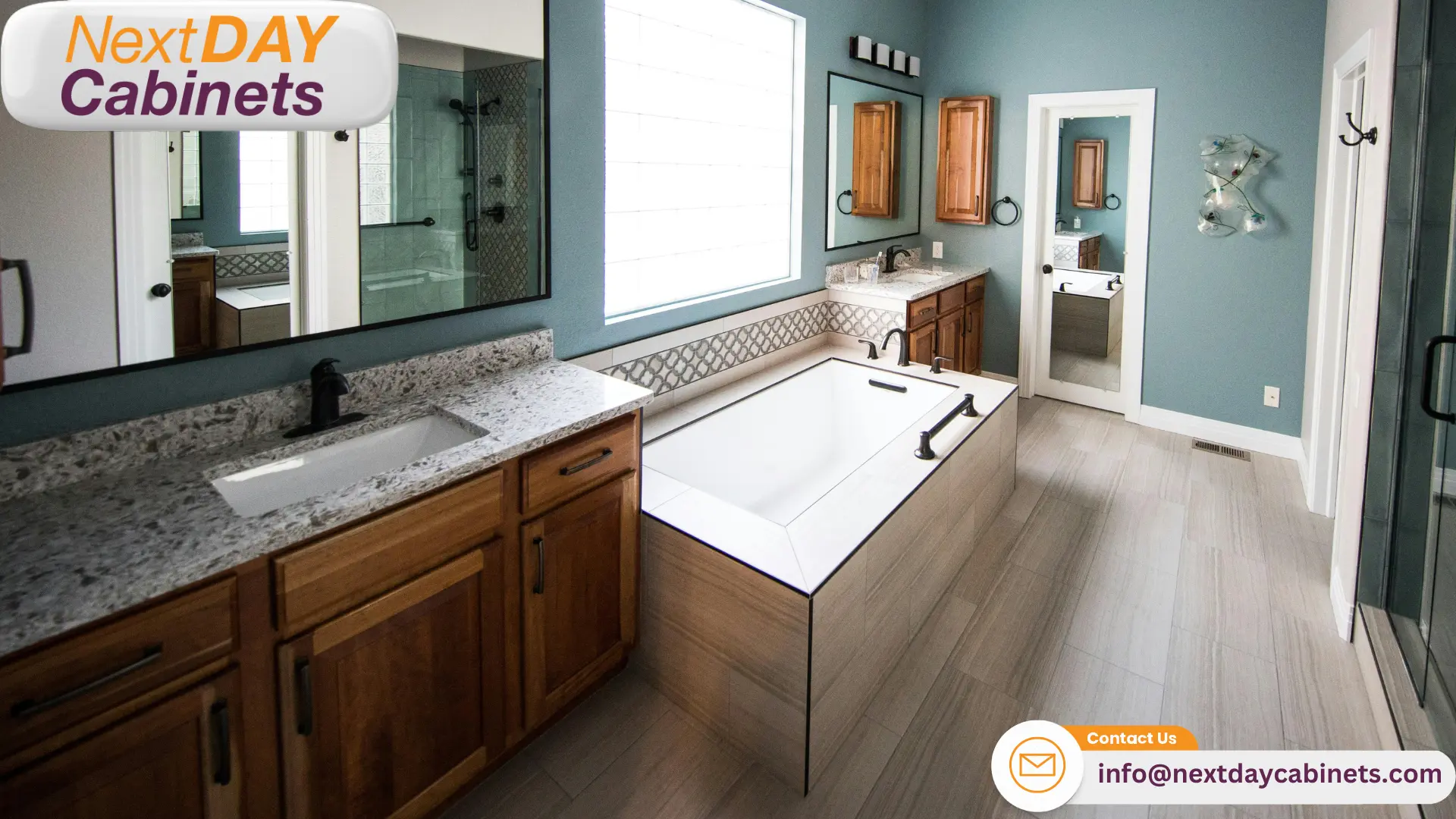
Sink and Faucet Selections for Functionality
Selecting appropriate sinks and faucets is crucial for bathroom vanity functionality. This section examines undermount and vessel sink options, various faucet types and finishes, and ensuring compatibility with vanity designs. Contractors will learn to balance aesthetics with practicality, considering installation requirements, water efficiency, and durability to create optimal bathroom solutions for their clients.
Choosing Between Undermount and Vessel Sinks
When selecting bathroom vanities, contractors must carefully consider the choice between undermount and vessel sinks. Undermount sinks offer a sleek, seamless appearance and easy countertop cleaning, making them ideal for modern bathroom designs. These sinks provide a flush surface with the countertop, creating a cohesive look and maximizing usable space.
Vessel sinks, on the other hand, sit atop the vanity counter, serving as a focal point in the bathroom. They offer versatility in design and are available in various materials such as glass, ceramic, and stone. Contractors should consider height requirements, faucet compatibility, and potential splashing issues when recommending vessel sinks. The choice between undermount and vessel sinks ultimately depends on the client’s aesthetic preferences, practical needs, and the overall bathroom design:
- Assess bathroom size and layout.
- Consider countertop material compatibility.
- Evaluate maintenance requirements
- Factor in installation complexity
- Analyze the impact on storage space.
Selecting Faucet Types and Finishes
Selecting faucet types and finishes is a crucial aspect of bathroom vanity design. Contractors should consider factors such as water efficiency, ease of use, and compatibility with the chosen sink style. Single-handle faucets offer simplicity and easy temperature control, while widespread faucets provide a more traditional look with separate hot and cold handles.
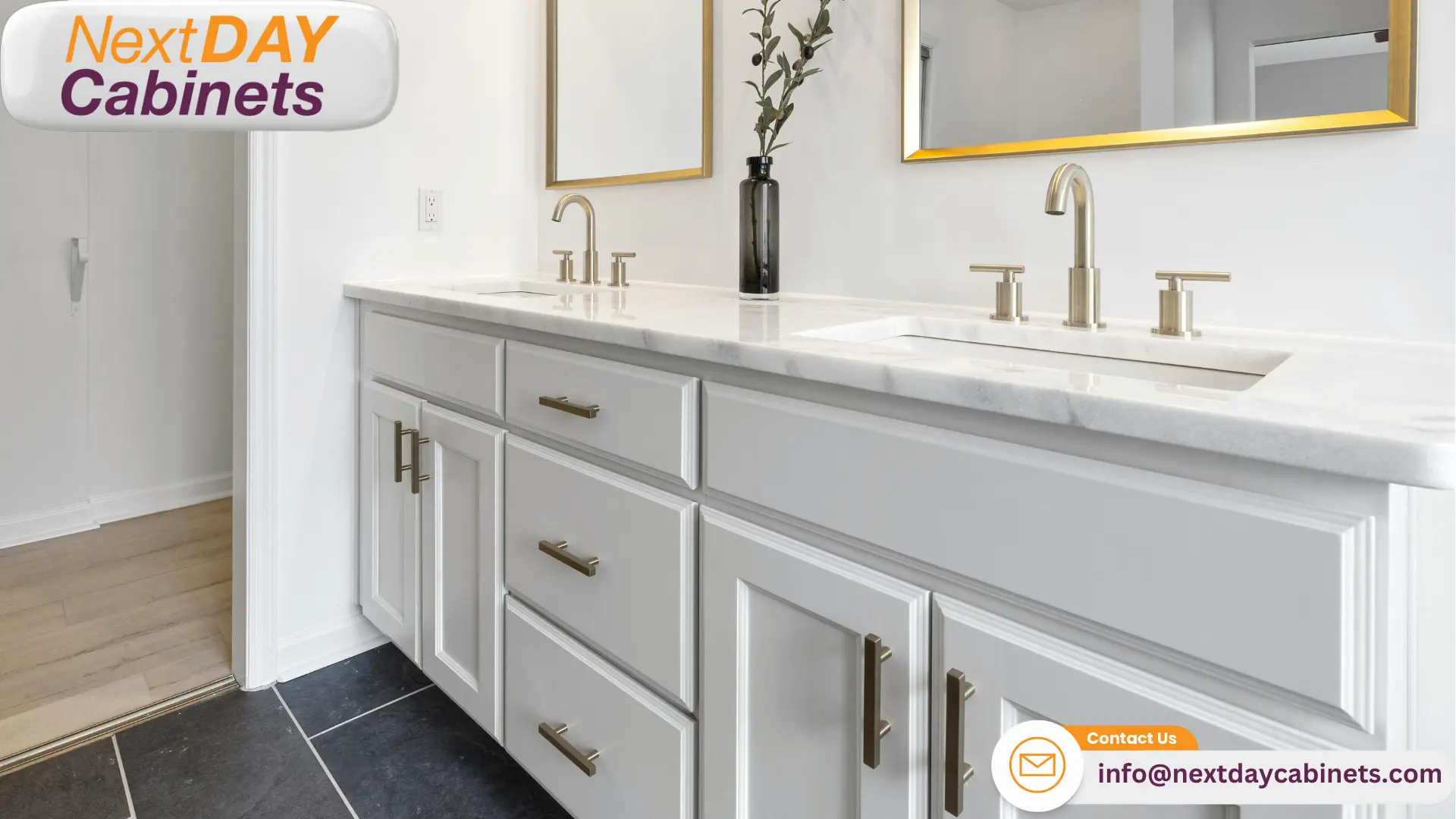
When recommending finishes, professionals must balance durability with aesthetic appeal. Popular options include brushed nickel for its versatility and resistance to water spots, chrome for its classic shine and affordability, and oil-rubbed bronze for a rustic or vintage-inspired look. Contractors should advise clients on the maintenance requirements of different finishes to ensure long-term satisfaction:
- Assess water pressure compatibility.
- Consider ADA compliance for accessibility.
- Evaluate installation requirements
- Compare warranty offerings
- Analyze finish durability in high-moisture environments.
Ensuring Compatibility With Vanity Design
Ensuring compatibility between vanity design and sink and faucet selections is crucial for creating a cohesive and functional bathroom space. Contractors must consider the vanity‘s dimensions, style, and construction when recommending sink and faucet options. For instance, a wall-mounted vanity may require a specific sink depth to maintain proper clearance, while a traditional cabinet-style vanity offers more flexibility in sink selection.
The chosen faucet should complement the vanity‘s overall aesthetic while meeting practical requirements. Contractors should evaluate the vanity‘s pre-drilled holes or recommend custom drilling to accommodate the desired faucet configuration. Additionally, they must ensure that the faucet’s reach is appropriate for the sink size and placement, preventing water splashing and ensuring comfortable use for the client.
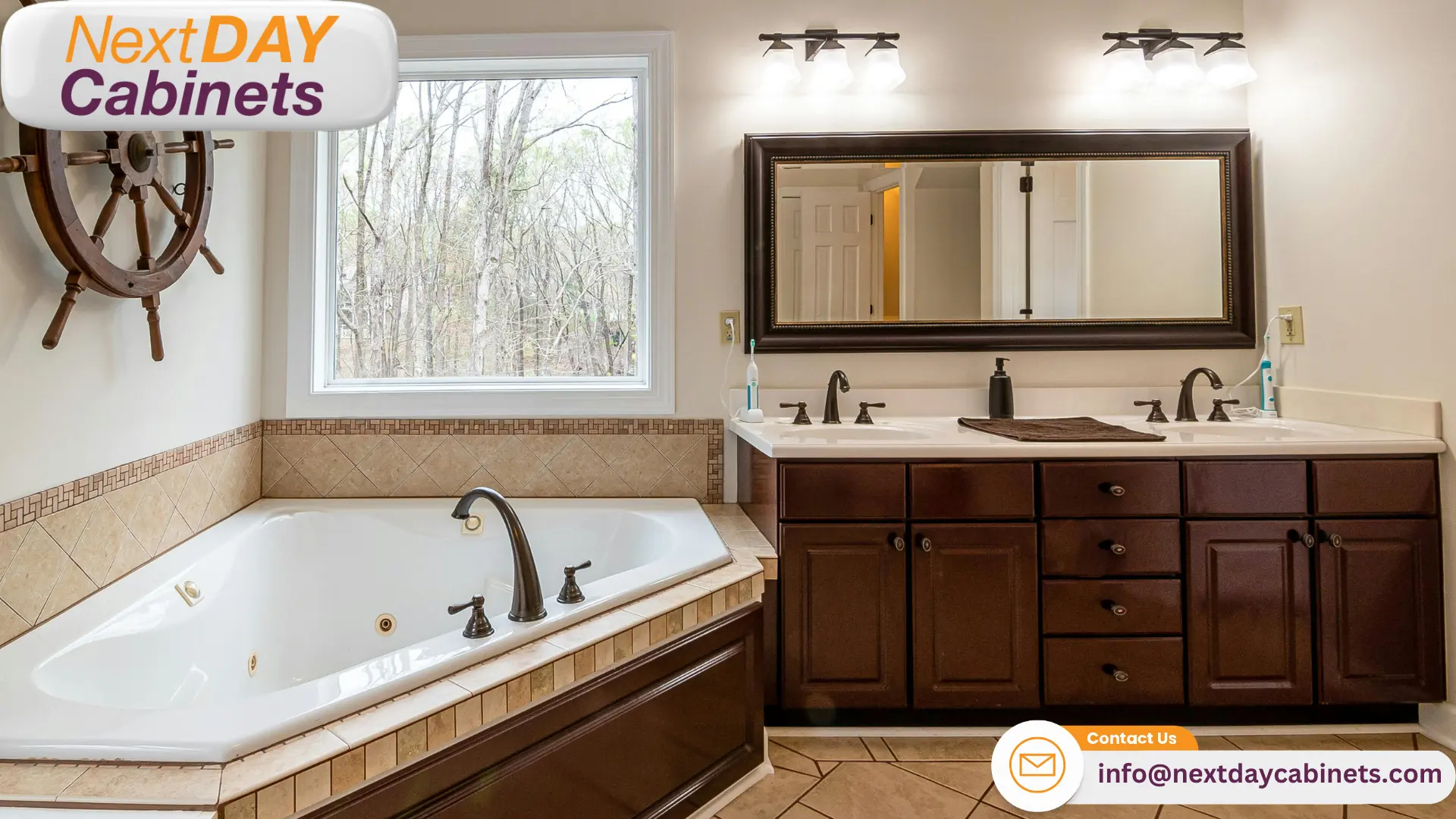
Lighting and Mirror Considerations
Proper lighting and mirror selection are essential for functional and aesthetically pleasing bathroom vanities. This section explores enhancing illumination with vanity lights, selecting mirrors for style and practicality, and integrating innovative features and technology. Contractors will learn to create well-lit, visually appealing spaces that meet modern design standards and client expectations.
Enhancing Illumination With Vanity Lights
Enhancing illumination with vanity lights requires careful consideration of fixture placement and light quality. Contractors should recommend side-mounted sconces or vertical fixtures flanking the mirror to provide even facial illumination, reduce shadows, and enhance visibility for grooming tasks. The ideal placement is at eye level, approximately 65-70 inches from the floor, ensuring optimal light distribution across the vanity area.
When selecting vanity lights, contractors must consider both functionality and aesthetics. LED fixtures offer energy efficiency and long-term cost savings while providing excellent color rendering for accurate makeup application. Dimmable options allow users to adjust light levels for different times of day or tasks, enhancing the overall versatility of the bathroom space. Contractors should also ensure that the chosen fixtures complement the vanity‘s style and finish, creating a cohesive design throughout the bathroom.
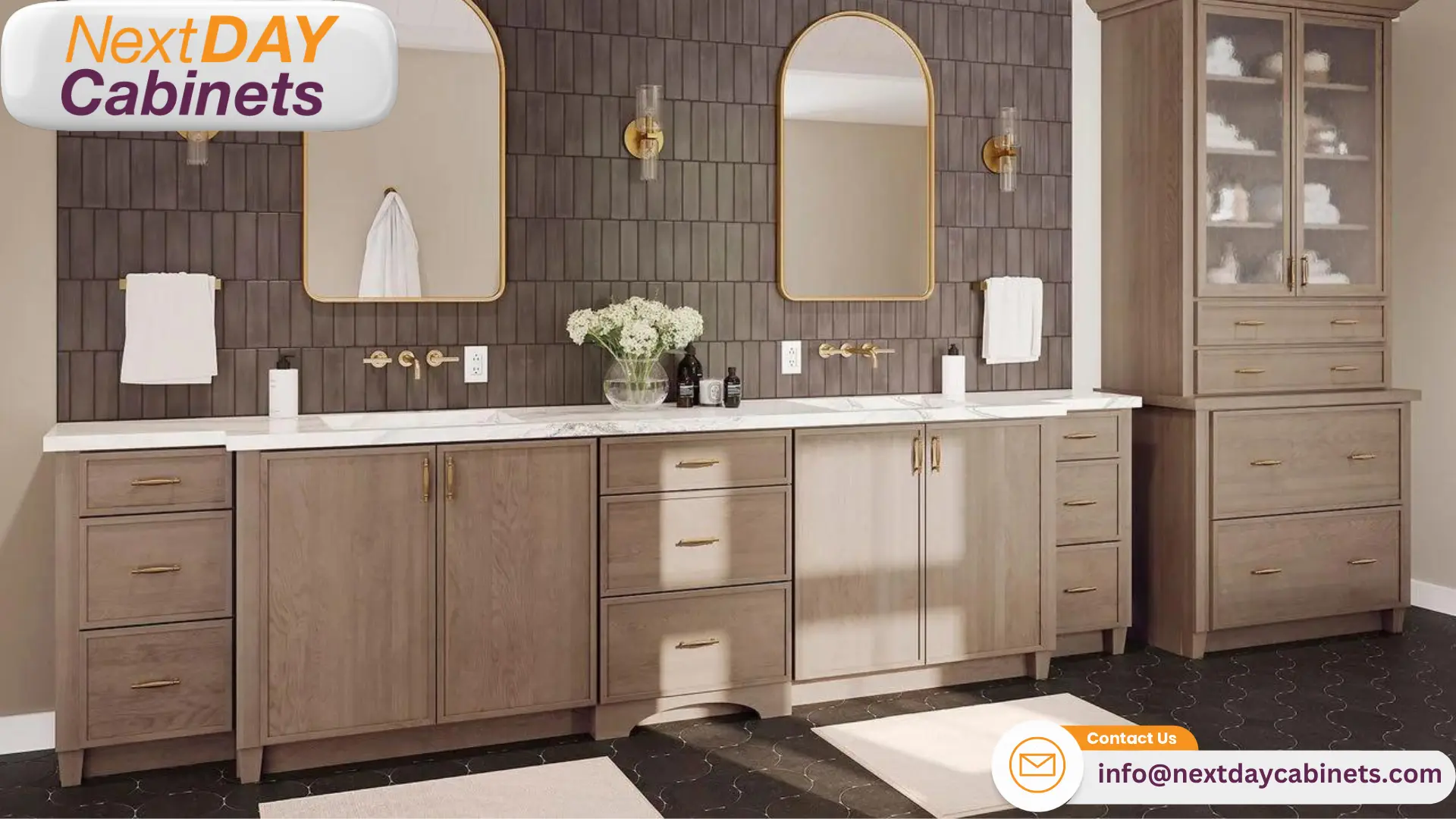
Selecting Mirrors for Style and Practicality
Selecting mirrors for bathroom vanities requires balancing style with practicality. Contractors should recommend mirrors complementing the vanity‘s design while providing adequate reflection coverage. Frameless mirrors offer a sleek, modern look and can make small bathrooms appear more prominent, while framed mirrors add a decorative element and can tie into the overall bathroom theme.
Contractors must consider mirror size and placement to ensure optimal functionality. The mirror should be at least as wide as the vanity and positioned at a height suitable for users of varying heights. For added practicality, professionals can suggest mirrors with integrated features such as anti-fog coatings or built-in lighting, enhancing the user experience and adding value to the bathroom design.
Integrating Smart Features and Technology
Integrating innovative features and technology into bathroom vanities enhances functionality and user experience. Contractors can recommend mirrors with built-in LED lighting and touch sensors for seamless operation. These smart mirrors often include features like adjustable color temperature and brightness, allowing users to customize their lighting for different tasks or times of day.
Voice-activated controls and Bluetooth connectivity offer additional convenience, enabling hands-free lighting and other bathroom features. Contractors should consider recommending vanities with integrated power outlets and USB charging ports to accommodate modern grooming devices and smartphones. When selecting innovative features, professionals must ensure compatibility with existing home automation systems and evaluate the long-term reliability of the technology:
- Assess client’s technology preferences and needs.
- Evaluate compatibility with existing home systems
- Consider power requirements for smart features
- Recommend water-resistant technology for bathroom use
- Provide guidance on maintenance and updates for smart devices.
Installation Tips From a Contractor’s Perspective
Successful bathroom vanity installation requires careful preparation, problem-solving skills, and proper maintenance. This section covers essential bathroom preparation steps, addresses common installation challenges, and provides aftercare tips to ensure longevity. Contractors will gain valuable insights to streamline installation and deliver high-quality client results.
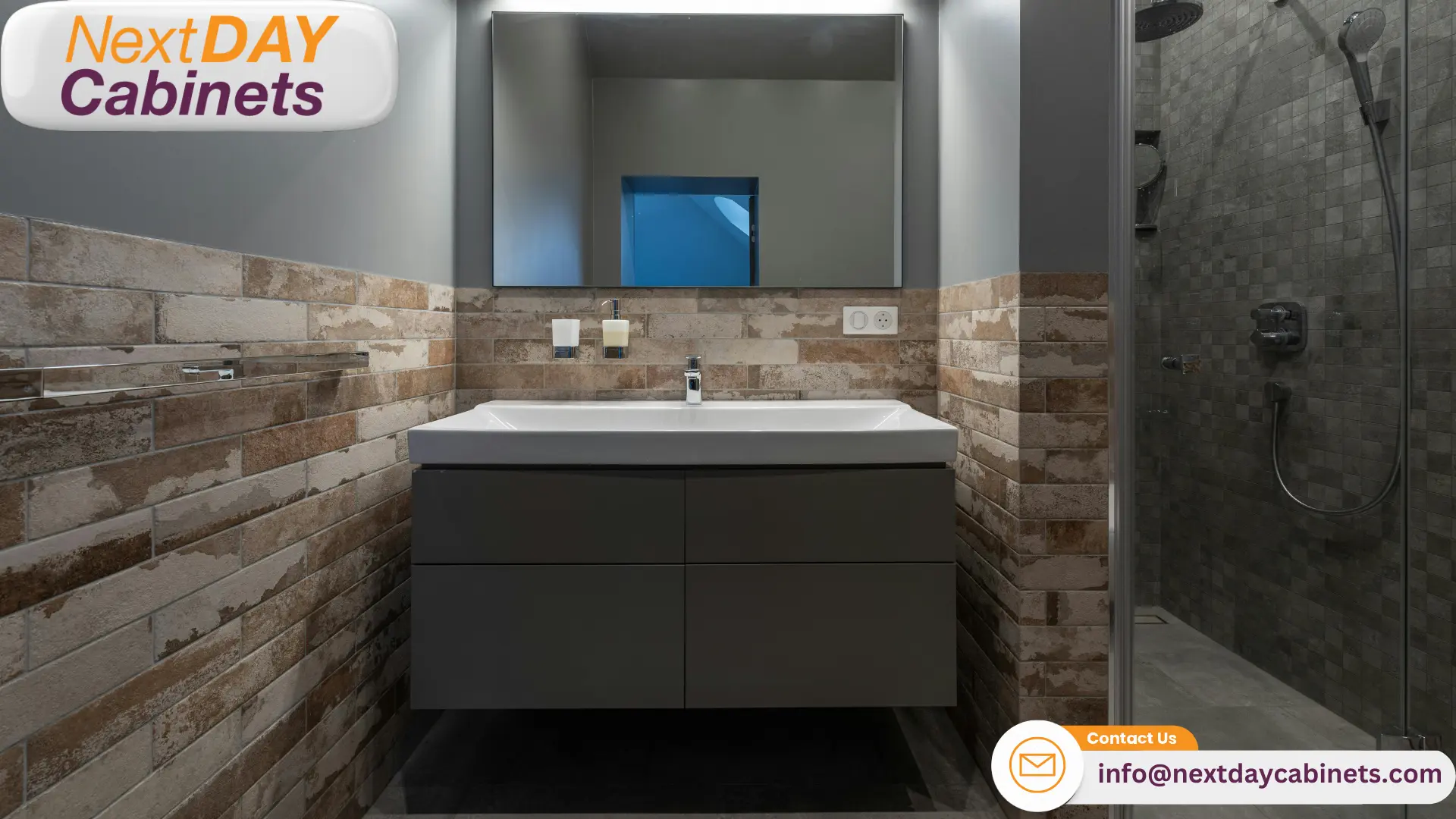
Preparing Your Bathroom for Installation
Preparing the bathroom for vanity installation requires careful planning and execution. Contractors should remove existing fixtures and disconnect proper plumbing and electrical components. They must carefully inspect the subfloor and wall structures for any damage or moisture issues that could affect the new installation.
Accurate measurements and marking key installation points are crucial for a successful vanity installation. Contractors should verify the location of studs, water supply lines, and drain pipes, making any necessary adjustments to accommodate the new vanity. Proper preparation also includes protecting surrounding surfaces and ensuring adequate ventilation during the installation process:
- Remove existing fixtures and disconnect utilities.
- Inspect subfloor and wall structures
- Take accurate measurements and mark key points
- Verify locations of studs and plumbing
- Protect surrounding surfaces
- Ensure proper ventilation.
Common Installation Challenges and Solutions
Contractors often encounter uneven walls and floors during bathroom vanity installations. Professionals should use shims to level the vanity to address this challenge and ensure proper alignment. For severe cases, contractors may need to install a plywood subfloor or use a self-leveling compound to create a flat surface before installing the vanity.
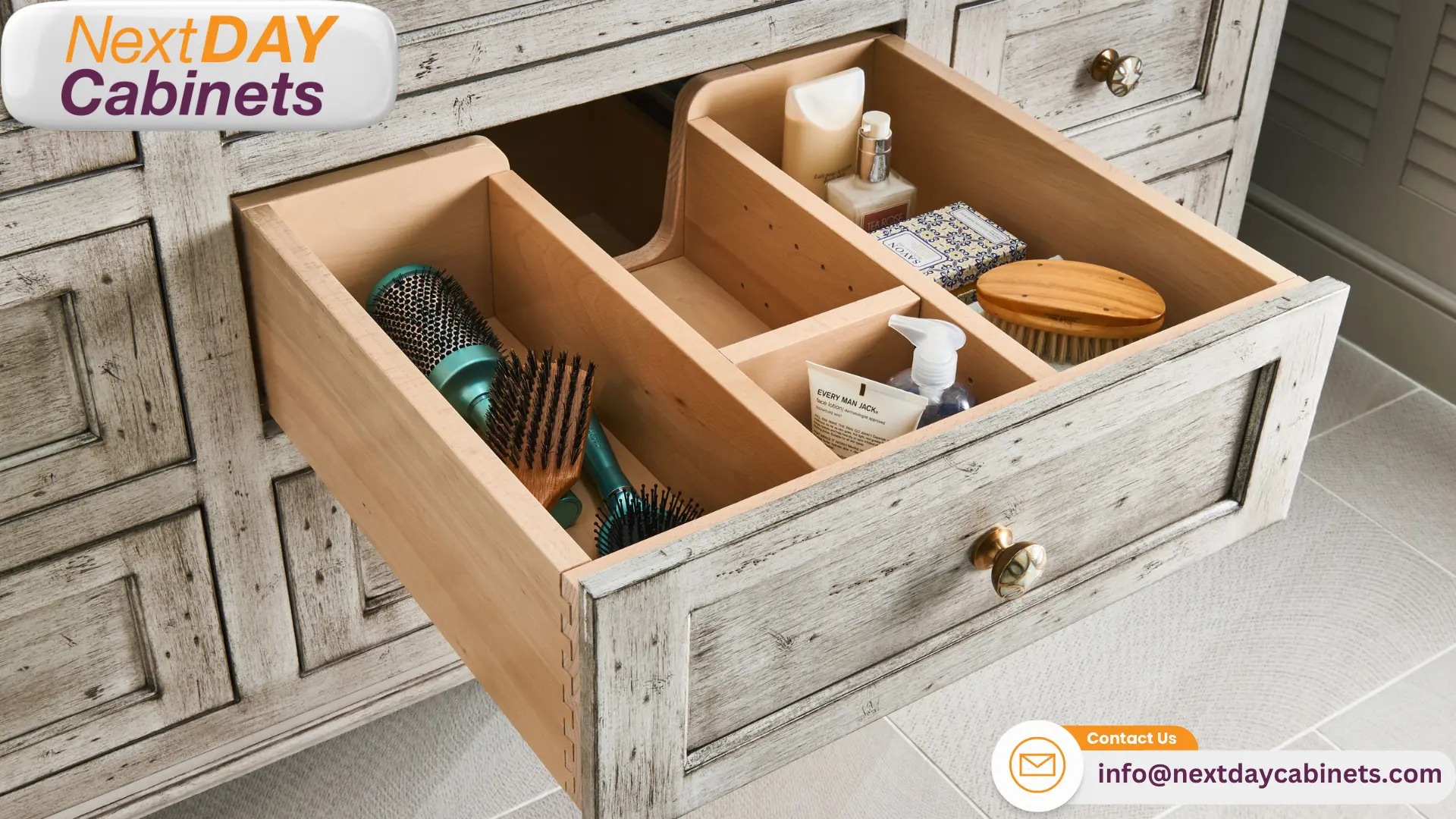
Plumbing misalignments pose another common installation hurdle. Contractors should be prepared to modify existing plumbing to accommodate the new vanity‘s configuration. This may involve extending or rerouting water supply lines and drain pipes. In some cases, using flexible PEX tubing or offset drain fittings can provide the necessary adjustability to overcome plumbing discrepancies:
| Challenge | Solution |
|---|---|
| Uneven surfaces | Use shims or self-leveling compound |
| Plumbing misalignment | Modify pipes or use flexible fittings |
| Limited space | Custom-fit vanity or wall-mounted design |
Aftercare and Maintenance for Longevity
Proper aftercare and maintenance are crucial for ensuring the longevity of newly installed bathroom vanities. Contractors should educate clients on the importance of regular cleaning and sealing vanity surfaces, particularly for natural stone countertops. They should recommend specific cleaning products suitable for the vanity‘s materials, emphasizing the need to avoid harsh chemicals that could damage finishes or hardware.
Periodic inspections of plumbing connections and hardware are essential for preventing water damage and maintaining functionality. Contractors should provide clients with a maintenance checklist that includes:
- Checking for loose hinges or drawer slides
- Inspecting caulk and grout lines for signs of wear
- Monitoring drain performance and addressing clogs promptly
- Lubricating drawer slides and door hinges as needed
- Assessing moisture levels in the vanity area to prevent mold growth.
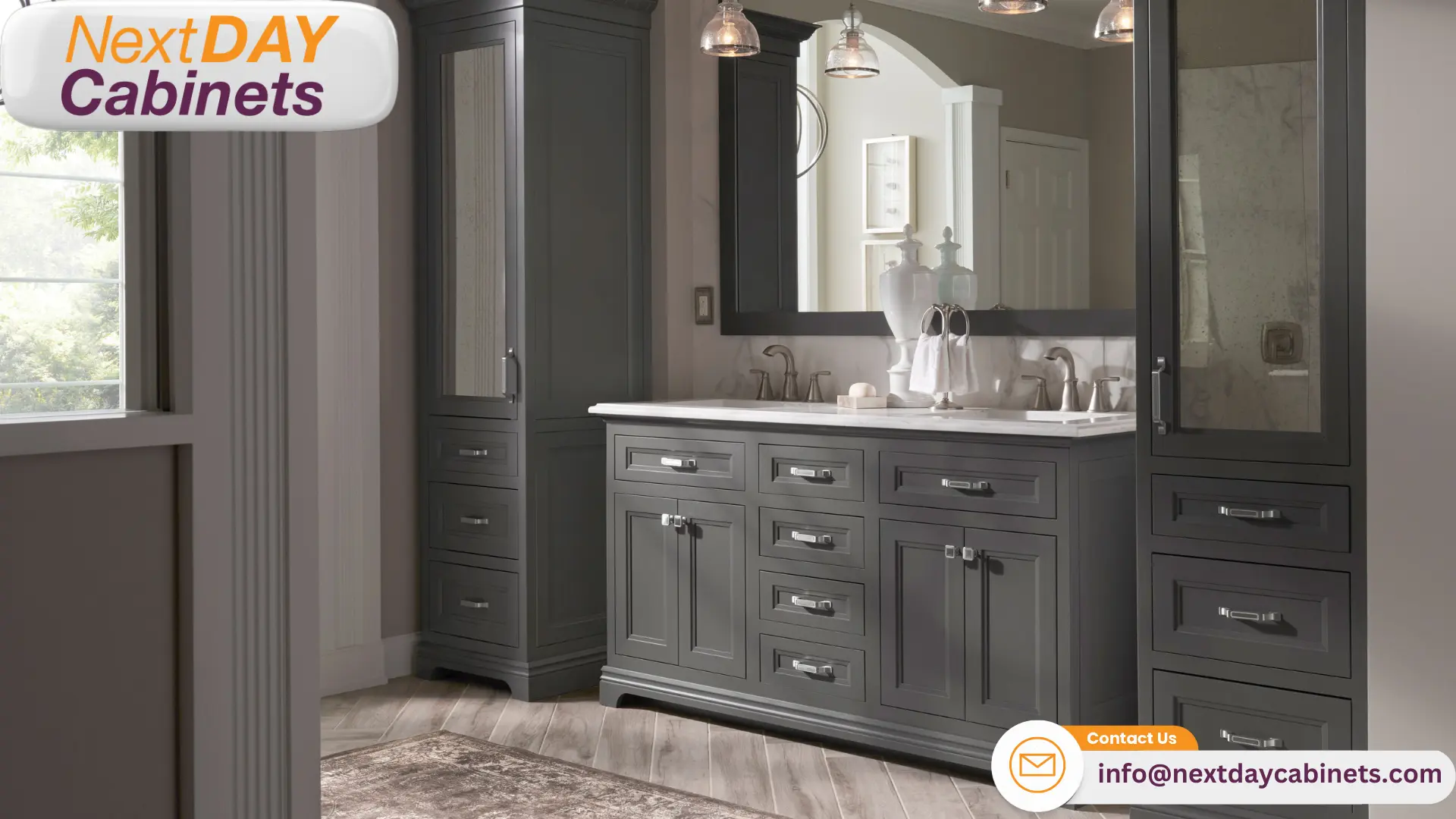
FAQs for Choosing Bathroom Vanities Wisely
How do I choose a bathroom vanity?
Choosing bathroom vanities requires balancing functionality, aesthetics, and space optimization. Begin by assessing the available space in your bathroom. Consider the placement of existing plumbing and electrical fixtures, as relocating these can significantly increase renovation costs. Also, ensure the vanity complements your bathroom’s modern, traditional, or transitional style. Consider vanity-size storage solutions, countertop materials, sink selection, and faucet types.
Consider vanities with smart features like built-in lighting or charging ports for enhanced client satisfaction. Lastly, the vanity should match the overall design flow of the bathroom, including mirror styles and lighting fixtures.
What makes a good bathroom vanity?
A good bathroom vanity combines durability, functionality, and aesthetics. Material selection is crucial—opt for moisture-resistant materials such as plywood or MDF with a veneer finish to withstand the humid bathroom environment. A good vanity provides ample storage solutions, keeping the bathroom clutter-free while optimizing space. Additionally, it should align with the room’s design and offer countertop space for daily essentials.
Custom vanities offer even more flexibility, allowing you to tailor storage, sink placement, and size to your unique needs. The faucet, sink, and lighting fixtures you choose will also enhance the overall usability and style.
What are bathroom vanities usually made of?
Bathroom vanities are typically made from various materials designed for durability and moisture resistance. Common choices include solid wood, plywood, MDF (medium-density fiberboard), and particleboard. Solid wood offers premium durability and a classic aesthetic but requires more maintenance to prevent warping in humid environments. Plywood is a sturdy option that resists water damage better than solid wood. MDF is budget-friendly and often comes with a veneer or laminate finish to protect against moisture.
Popular countertop materials include quartz, granite, marble, and laminate, each providing different durability and maintenance requirements. When choosing bathroom vanities, consider material selection carefully based on your budget and bathroom conditions.
What are the different types of bathroom vanity?
There are several types of bathroom vanities, each catering to different needs and design preferences:
- Freestanding Vanities: These are traditional and versatile, offering ample storage and style flexibility.
- Wall-Mounted Vanities: Ideal for space optimization, these vanities create an illusion of more space and offer a modern, minimalist look.
- Corner Vanities: Perfect for small bathrooms or powder rooms, corner vanities maximize space without sacrificing functionality.
- Double-sink vanities are a popular choice for master bathrooms. They provide two sinks and additional countertop space for shared usage.
- Custom Vanities: Custom vanities are tailored to your specific needs. You can choose the size, storage options, countertop materials, and even innovative features for added convenience. When choosing bathroom vanities, assess your room’s layout and plumbing considerations to select the best type that complements style and functionality.
What is the best color for a bathroom vanity?
The best color for a bathroom vanity largely depends on your bathroom’s overall design and the ambiance you want to create. Neutral tones such as white, gray, and beige are timeless and work well in any bathroom style, creating a clean, airy look. Darker shades like navy, black, or charcoal add a bold, dramatic touch to modern bathrooms, while wood tones, such as oak or walnut, bring warmth and a natural feel to traditional or rustic spaces.
When choosing bathroom vanities, consider lighting and mirror styles to ensure the vanity color enhances the overall aesthetic of your bathroom. For a trendy look in 2024, two-tone vanities, mixing wood and painted finishes, are becoming increasingly popular in renovation projects.
What is the rule for bathroom colors?
There’s no strict rule, but bathroom colors are often chosen for their ability to create a relaxing and inviting atmosphere. Light colors like white, cream, and pale blues can make a space feel larger and brighter, while darker shades like navy, gray, or black can create a more sophisticated and dramatic ambiance. Ultimately, the best color choice depends on your personal preferences and the overall style of your bathroom. NextDAY Cabinets offers a wide range of cabinet finishes and colors, allowing you to find the perfect match for your vision.
What color cabinets increase home value?
While the color of your cabinets can influence a buyer’s perception, it’s not the sole factor determining home value. However, neutral colors like white, gray, and beige are more universally appealing and can create a sense of spaciousness. These colors also allow for greater flexibility when decorating and accessorizing the space. NextDAY Cabinets specializes in high-quality, all-wood cabinets, ensuring durability and longevity for your investment. Our neutral color options can help you create a timeless and appealing bathroom that will stand the test of time.
What color vanity is used to make a bathroom look bigger?
Light-colored vanities can visually expand a small bathroom. White or cream vanities, especially with light-colored countertops, can reflect more light, making the space feel larger. You can also use mirrors strategically to create the illusion of more space. NextDAY Cabinets offers a wide selection of vanity styles and sizes, including space-saving options that can help you maximize your bathroom’s potential. Our expert design team can help you choose the perfect vanity to create a spacious and stylish bathroom.
How to pick a bathroom vanity?
Choosing bathroom vanities involves several key considerations to ensure functionality and aesthetics align with your renovation goals. Here are some essential steps:
- Measure Your Space: Start by measuring the area where the vanity will be installed. Consider the vanity size, ensuring it fits well without crowding the space.
- Material Selection: Opt for durable materials that can withstand moisture. Solid wood, plywood, and high-quality MDF are popular choices for their longevity and resistance to warping.
- Style Matching: The vanity should complement the overall design of your bathroom. Whether you prefer modern, rustic, or traditional styles, ensure it harmonizes with existing fixtures and decor.
- Storage Solutions: Assess your storage needs. Choose a vanity with sufficient drawers and cabinets to keep your bathroom organized.
- Countertop Materials: Select a countertop that looks good and is also practical. Options like quartz, granite, and marble offer durability and style.
- Sink Selection and Faucet Types: Decide on the sink style (undermount, vessel, etc.) and choose faucets that match the sink and the overall aesthetic.
- Lighting Fixtures and Mirror Styles: Consider how lighting will affect the space. A well-chosen mirror can enhance both functionality and style.
- Smart Features: If desired, incorporate smart features like built-in charging stations or LED lighting for convenience.
- Installation Preparation: Ensure plumbing assessments and electrical considerations are made before installation to avoid complications later.
Following these guidelines when choosing bathroom vanities, you can create a beautiful, functional space that meets your needs.
What is the most timeless bathroom vanity color?
The most timeless bathroom vanity color is often considered to be white. This classic hue offers a clean and fresh look that complements various design styles. White vanities can quickly adapt to changing decor trends without becoming outdated.
Other timeless colors include:
- Soft grays
- Navy blue
- Light beige
These shades provide versatility while maintaining a sophisticated aesthetic that can blend seamlessly with various wall colors and fixtures.
What makes a good quality bathroom vanity?
Several key features characterize a good-quality bathroom vanity:
- Durable Materials: High-quality vanities are constructed from solid wood or high-grade plywood rather than particle board, which can deteriorate over time.
- Sturdy Construction: Look for dovetail joints in drawers and soft-close mechanisms that enhance durability and ease of use.
- Water Resistance: Quality finishes should be moisture-resistant to prevent damage from humidity in bathrooms.
- Functional Design: A well-designed vanity should offer adequate storage solutions while easily accessible.
- Aesthetic Appeal: The finish, hardware, and overall style should align with your bathroom’s decor while standing the test of time regarding design trends.
Investing in a high-quality vanity ensures longevity and enhances client satisfaction during renovations.
What is the most popular color for bathroom vanity?
Currently, the most popular colors for bathroom vanities include:
- White: Offers a classic look that pairs well with any decor.
- Gray: A versatile neutral that adds modern sophistication.
- Navy Blue: Provides a bold statement while remaining elegant.
These colors are favored for enhancing space optimization while maintaining a stylish appearance.
Should bathroom cabinets be lighter or darker than walls?
When choosing between lighter or darker cabinets compared to walls, consider the following:
- Lighter Cabinets can create the illusion of more space, making them ideal for smaller bathrooms. They also better reflect light, enhancing brightness in the room.
- Darker Cabinets can add depth and drama to larger spaces. Darker shades often convey luxury, but carefully considering lighting fixtures may be required to ensure the area remains bright enough.
Ultimately, choosing lighter or darker cabinets depends on personal preference and the overall design scheme of your bathroom. Balancing colors effectively can lead to an aesthetically pleasing environment that maximizes functionality.
What color is most flattering in a bathroom?
When choosing bathroom vanities, the most flattering color depends on the specific space and lighting conditions. However, many homeowners and designers find that light, neutral colors are the most universally flattering in bathrooms. Soft whites, creams, and light grays can create a bright, clean appearance that enhances the perception of space. These colors also provide an excellent backdrop for styling with accessories and can complement various countertop materials and sink selections.
That said, the key to a flattering bathroom color lies in balancing aesthetics with functionality. Consider how the vanity color will interact with your lighting fixtures, mirror styles, and overall bathroom design. Some homeowners opt for bolder colors like navy blue or forest green for a more dramatic effect, which can be equally flattering when executed thoughtfully.
What is the color trend for bathrooms in 2024?
In 2024, bathroom color trends are leaning towards a mix of serene neutrals and nature-inspired hues. When it comes to choosing bathroom vanities, we’re seeing a rise in the popularity of:
- Sage green: This calming, organic color is perfect for creating a spa-like atmosphere.
- Warm neutrals: Think taupe, beige, and greige (gray-beige), which offer a cozy yet sophisticated feel.
- Dusty blues: These soft, muted blues add a touch of color without overwhelming the space.
- Terracotta and earthy tones: These warm, grounding colors are returning to bathroom design.
These colors are not just about aesthetics but are also crucial in space optimization and style matching. These trendy colors can transform your bathroom into a modern oasis when paired with suitable countertop materials, sink selection, and lighting fixtures.
Remember, while trends are essential to consider, the best color for your bathroom vanity should also align with your style and the overall design of your home. Custom vanities offer the flexibility to choose colors that perfectly match your vision.
What color bathroom increases home value?
Regarding increasing home value through bathroom renovations, including choosing bathroom vanities, neutral colors are the safest bet. Colors that have been shown to increase home value potentially include:
- White: Classic and timeless, white bathrooms often appeal to many potential buyers.
- Light gray: This modern neutral can make a space feel larger and more luxurious.
- Beige or greige: These warm neutrals create a cozy, inviting atmosphere.
However, it’s important to note that increasing home value isn’t just about color. It’s about the overall quality of the renovation, including factors like:
- Material selection: High-quality countertop materials and durable finishes can significantly impact value.
- Functionality: Smart features, ample storage solutions, and well-thought-out layouts are highly desirable.
- Craftsmanship: Professional installation and attention to detail in areas like plumbing assessments and electrical considerations can make a big difference.
While color is important, choosing bathroom vanities can significantly increase your home’s value. When planning your bathroom renovation, always consider the balance between aesthetics and functionality.
What color bathroom sells the most?
When selling homes, bathrooms that feature neutral colors tend to be the most universally appealing. Based on real estate trends and buyer preferences, the colors that seem to perform best in the market are:
- White: White bathrooms are clean, bright, and versatile, and they continue to be top sellers. White vanities, in particular, offer a blank canvas that allows potential buyers to envision their style.
- Light gray: This modern neutral has gained popularity in recent years. It’s sophisticated and can make a space feel larger.
- Beige and greige: These warm neutrals create a welcoming atmosphere and work well with various design styles.
However, it’s crucial to understand that the color alone doesn’t sell a bathroom. When choosing bathroom vanities and planning a renovation, consider these factors that contribute to a bathroom’s appeal:
- Vanity size and storage solutions: Ample, well-designed storage is a significant selling point.
- Quality of materials: Durable countertop materials and well-crafted cabinetry can significantly impact buyer perception.
- Overall design coherence: Ensure your vanity choice complements other elements, such as sink selection, faucet types, and mirror styles.
- Functionality: Features like double sinks, smart features, and efficient layouts can be major selling points.
- Lighting: Well-planned lighting fixtures can enhance the perceived value of the space.
Remember, while neutral colors may sell well, a thoughtfully designed bathroom that balances aesthetics with practical features will always be attractive to potential buyers. When choosing your bathroom vanities and planning your renovation, focus on creating a space that showcases style and functionality.
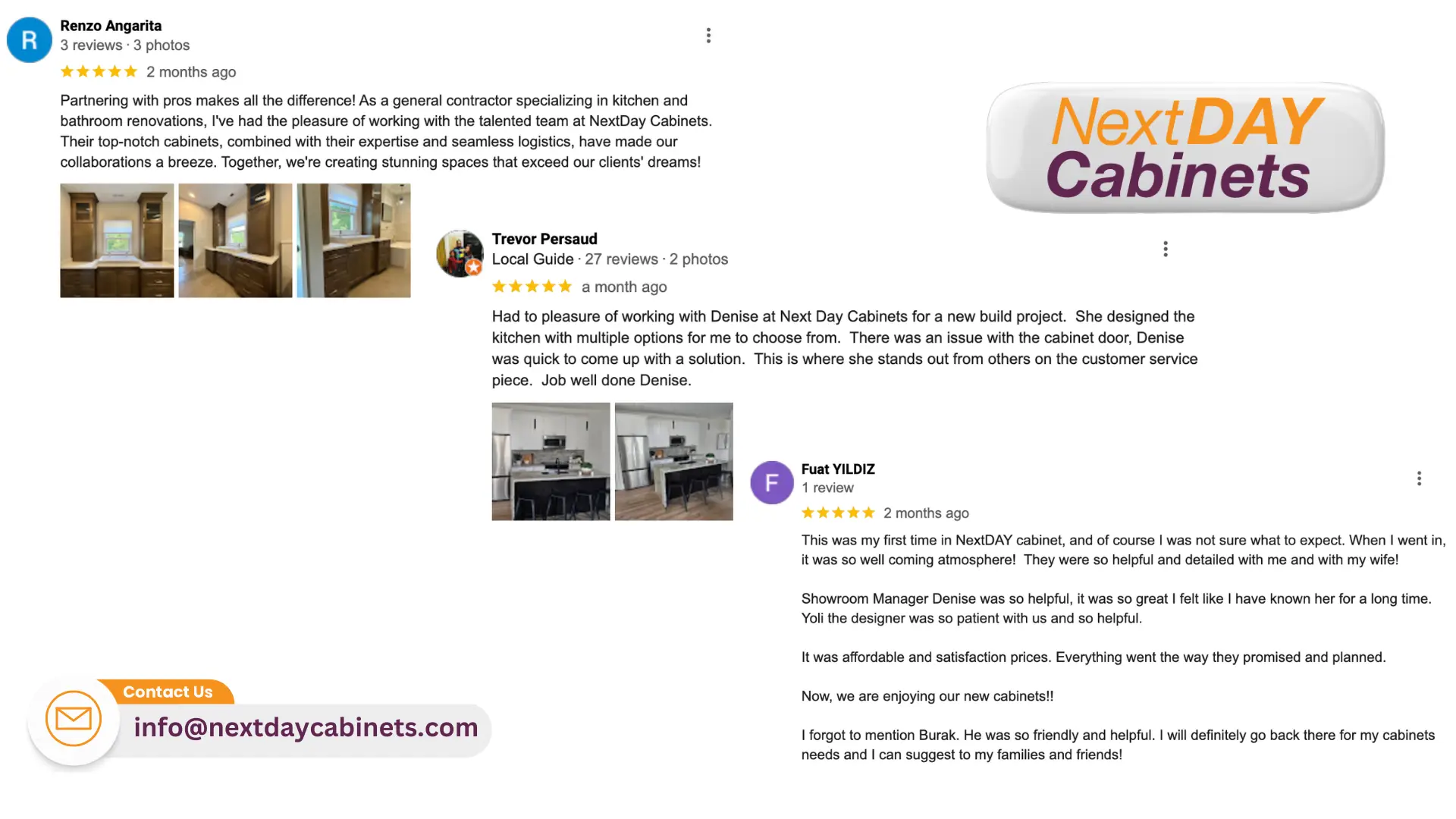
Hear from Our Delighted Clients About Choosing Bathroom Vanities Wisely
Renzo Angarita, General Contractor
Renzo Angarita, a general contractor specializing in kitchen and bathroom renovations, praises NextDay Cabinets for their partnership approach. He highlights the company’s top-notch cabinets, expertise, and seamless logistics, making collaborations effortless. Renzo emphasizes how this partnership enables them to create stunning spaces that exceed client expectations.
Trevor Persaud, New Build Project Client
Trevor Persaud commends Denise at NextDay Cabinets for her outstanding work on his new build project. He appreciates her design skills, offering multiple kitchen options. Trevor highlights Denise’s exceptional customer service, noting her quick and effective solution to a cabinet door issue.
Fuat YILDIZ, First-Time Customer
As a first-time customer, Fuat YILDIZ shares his excellent experience with NextDay Cabinets. He praises the welcoming atmosphere and the helpful, detailed attention provided by the staff. Fuat mentions Showroom Manager Denise for her exceptional assistance, designer Yoli for her patience, and Burak for his friendliness. He appreciates the affordable pricing and the company’s commitment to delivering as promised.
Choose NextDay Cabinets for your wholesale cabinet needs and experience the same level of satisfaction as Renzo Angarita, Trevor Persaud, and Fuat YILDIZ. Our dedicated team excels in providing high-quality cabinets, offering expert design assistance, and ensuring customer satisfaction across various projects.
From seasoned contractors to first-time customers, we pride ourselves on our attentive service, design expertise, and commitment to meeting deadlines. Our team, including standout members like Denise, Yoli, and Burak, is known for their competence, patience, and willingness to go the extra mile for our customers.
At NextDay Cabinets, you’ll find a wide range of beautiful cabinet options with competitive pricing, making us the go-to choice for homeowners, industry professionals, and contractors. Our quality focus, knowledgeable staff, and customer-first approach ensure that your cabinet selection and installation process will be smooth and satisfying.
Whether you’re a professional contractor looking for a reliable partner, planning a new build project, or a first-time customer exploring cabinet options, NextDay Cabinets is committed to exceeding your expectations with our product quality, design services, and outstanding customer support. We stand behind our products and are dedicated to resolving any issues that may arise, ensuring your complete satisfaction.
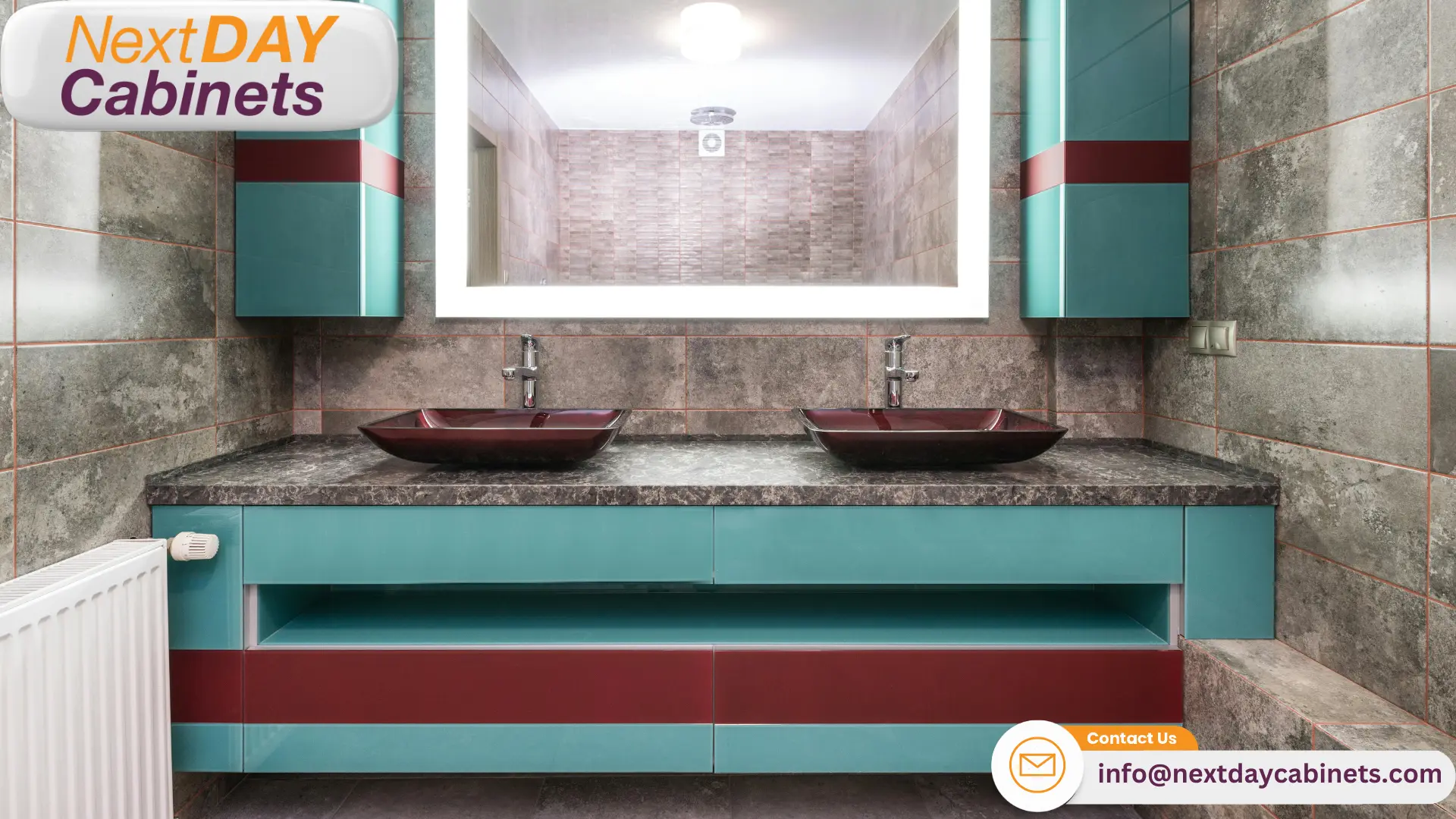
Transform Your Home with NextDAY Cabinets
NextDay Cabinets offers a wide range of high-quality kitchen cabinets and bathroom vanities at affordable prices. As the Mid-Atlantic’s best cabinet wholesaler, we serve six locations: Chantilly, Alexandria, Woodbridge, Richmond, Beltsville, and Chicago.
Visit Our Showrooms
- Chantilly Showroom: 14000 Thunderbolt Pl Suite K, Chantilly, VA 20151
- Alexandria Showroom: 5655 General Washington Dr., Suite E, Alexandria, VA 22312
- Woodbridge Showroom: 3099 PS Business Center Dr, Woodbridge, VA 22192
- Richmond Showroom: 3985 Deep Rock Rd, Richmond, VA 23233
- Beltsville Showroom: 5801 Ammendale Rd, Beltsville, MD 20705
- Chicago Showroom: 1801 Estes Ave, Elk Grove Village, IL 60007
Why Choose NextDAY Cabinets?
- Guaranteed Lowest Price: We ensure customer happiness and loyalty by providing top-quality construction at low factory-direct prices.
- Fast Lead Times: We offer some of the fastest lead times in the industry, with many orders ready in just 3-5 days.
- Professional Design Services: Our experienced design consultants help you create the perfect kitchen for your needs.
- High-Quality Products: All our cabinets are made from 100% solid wood and are KCMA certified, ensuring durability and environmental safety.
NextDAY Cabinets offers the best American made cabinet brands like:
Crestwood, Decora, Forevermark Cabinetry, Mantra, Marsh, Nations Cabinetry, Waypoint, WellKraft Cabinetry, Wolf Home Product in Mid-Atlantic area with 6 showrooms in Chantilly, Alexandria, Woodbridge, Richmond, Beltsville, and Chicago. Check out the exciting bathroom vanities with a wide range of choosing bathroom vanities options at NextDAY Cabinets now!
Contractors, Dealers, and Builders! Are You Ready to Transform Homes? Become a dealer now!
Visit our Gallery now! Contact us and start your journey toward modern homes today.
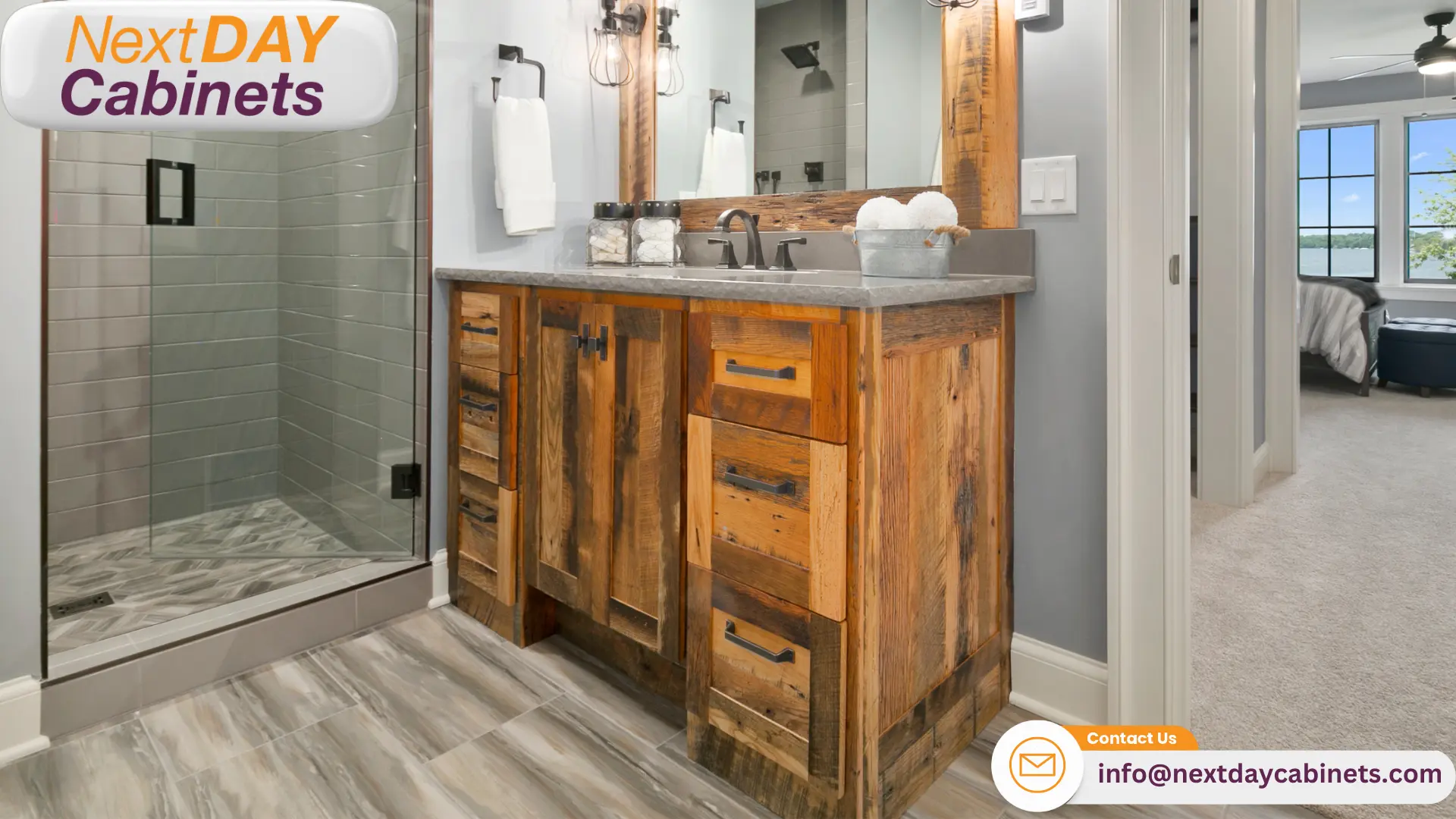
Conclusion
Selecting the right bathroom vanity is crucial for successful bathroom renovations. To ensure optimal functionality and aesthetics, contractors must consider factors such as space constraints, plumbing requirements, and client preferences.
Material choices play a significant role in vanity durability and style. Professionals should recommend options that balance quality, cost-effectiveness, and moisture resistance to meet client needs and project budgets.
Practical storage solutions and proper lighting are essential for creating functional and appealing bathroom spaces. Contractors should maximize storage capacity and integrate appropriate lighting fixtures to enhance the user experience.
By following the guidelines outlined in this guide, contractors can confidently navigate selecting and installing bathroom vanities. This knowledge enables professionals to deliver high-quality results that meet client expectations and industry standards.
